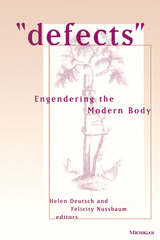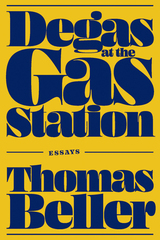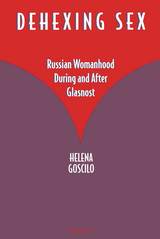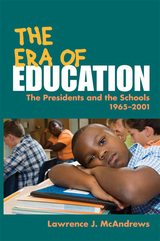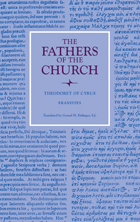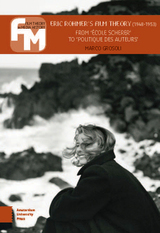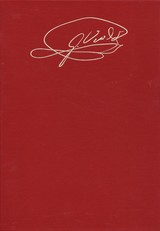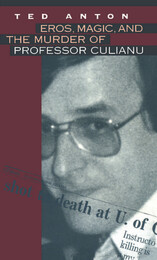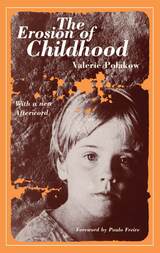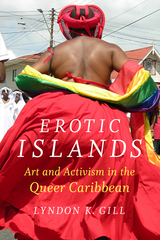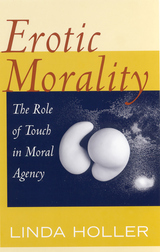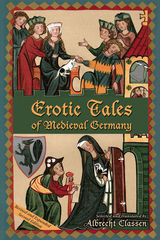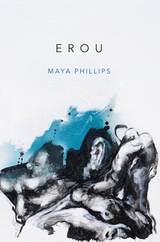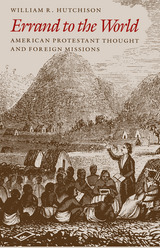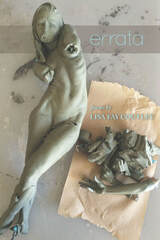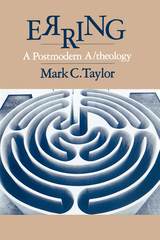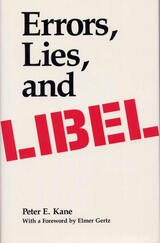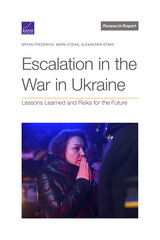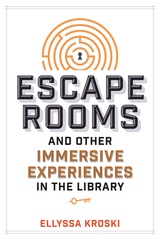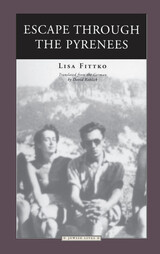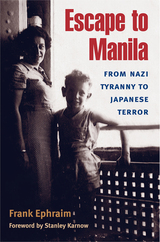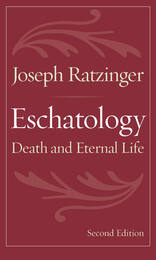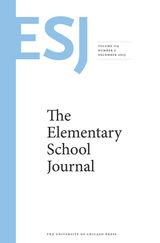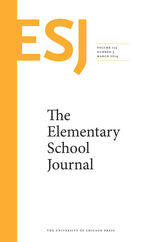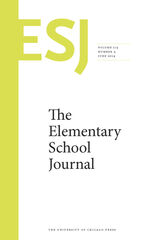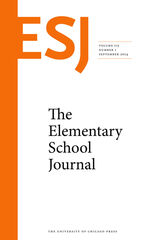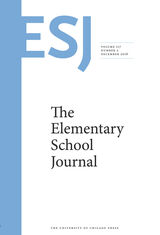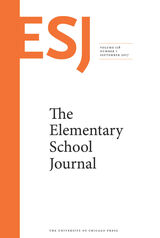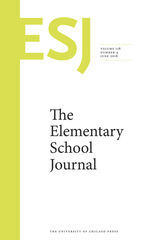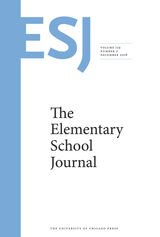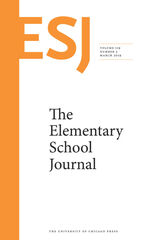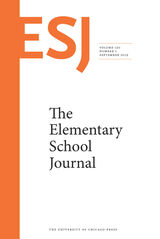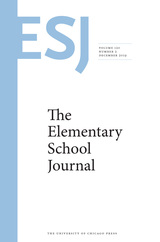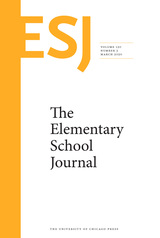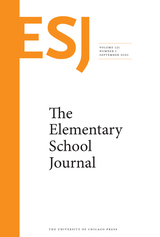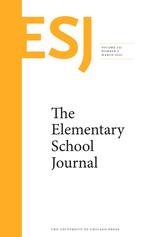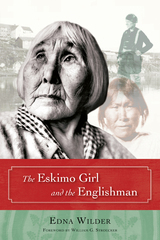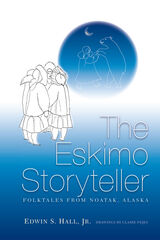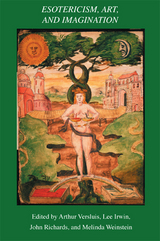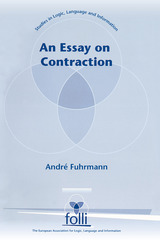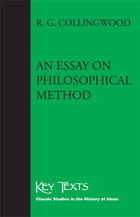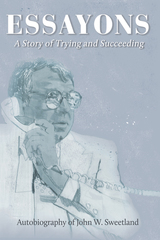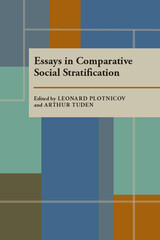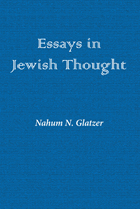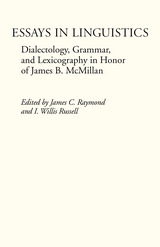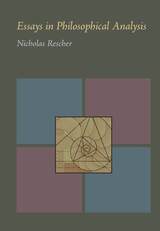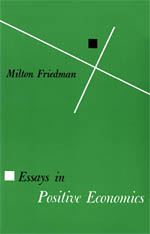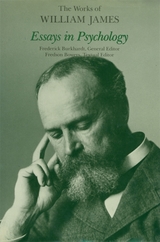The Era of Education: The Presidents and the Schools, 1965-2001
Lawrence J. McAndrews
University of Illinois Press, 2005 This study of educational policy from Lyndon Johnson through Bill Clinton focuses on three specific issues--public school aid, non-public (especially Catholic) school aid, and school desegregation--that speak to the proper role of the federal government in education as well as to how education issues embody larger questions of opportunity, exclusion, and equality in American society. Lawrence J. McAndrews traces the evolution of policy as each president developed (or avoided developing) a stance toward these issues and discusses the repercussions and implications of policy decisions for the educational community over nearly four decades.
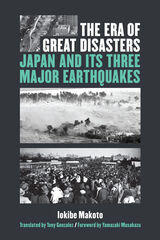 The Era of Great Disasters: Japan and Its Three Major Earthquakes
Makoto Iokibe; Translated by Tony Gonzalez
University of Michigan Press, 2020 The Era of Great Disasters examines modern disaster response in Japan, from the changing earthquake preparations and regulations, to immediate emergency procedures from the national, prefectural, and city levels, and finally the evolving efforts of rebuilding and preparing for the next great disaster in the hopes of minimizing their tragic effects. This book focuses on three major earthquakes from Japan’s modern history. The first is the 1923 Great Kantō Earthquake, which struck the capital region. The second is the 1995 Great Hanshin-Awaji Earthquake, affecting the area between Kobe and Osaka. The third is the 2011 Great East Japan Earthquake, the magnitude 9.0 quake that struck off the Pacific coast of the Tōhoku region, causing a devastating tsunami and the nuclear accident. While the events of (and around) each of these earthquakes are unique, Professor Iokibe brings his deep expertise and personal experience to each disaster, unveiling not only the disasters themselves but the humanity underneath. In each case, he gives attention and gratitude to those who labored to save lives and restore the communities affected, from the individuals on the scene to government officials and military personnel and emergency responders, in hope that we might learn from the past and move forward with greater wisdom, knowledge, and common purpose.
Eranistes
Theodoret of Cyrus
Catholic University of America Press, 2003 No description available
Erase Genesis
Rebecca Gayle Howell
Bridwell Press, 2025 “The earth / the earth / the earth / said”
In Erase Genesis, critically-acclaimed Kentucky poet and translator Rebecca Gayle Howell transforms the KJV creation story for the climate change age. Devoted to the same three chapters, Howell’s erasures raise a new myth—a story of the Earth’s intimacy with us. Here, man is not given dominion. Instead, the trees and the waters keep eternity, and the Lord Woman seeds tenderness as the only way forward.
A book-length poem with its roots in art, ecopoetry, progressive spirituality, and literary translation—Erase Genesis dismantles centuries of hurt as we bare our beginning anew, in abundance with Earth’s divine call:
“Be light and / let be”
 Erased: The Untold Story of the Panama Canal
Marixa Lasso
Harvard University Press, 2019 The Panama Canal's untold history—from the Panamanian point of view. Sleuth and scholar Marixa Lasso recounts how the canal’s American builders displaced 40,000 residents and erased entire towns in the guise of bringing modernity to the tropics.
The Panama Canal set a new course for the modern development of Central America. Cutting a convenient path from the Atlantic to the Pacific oceans, it hastened the currents of trade and migration that were already reshaping the Western hemisphere. Yet the waterway was built at considerable cost to a way of life that had characterized the region for centuries. In Erased, Marixa Lasso recovers the history of the Panamanian cities and towns that once formed the backbone of the republic.
Drawing on vast and previously untapped archival sources and personal recollections, Lasso describes the canal’s displacement of peasants, homeowners, and shop owners, and chronicles the destruction of a centuries-old commercial culture and environment. On completion of the canal, the United States engineered a tropical idyll to replace the lost cities and towns—a space miraculously cleansed of poverty, unemployment, and people—which served as a convenient backdrop to the manicured suburbs built exclusively for Americans. By restoring the sounds, sights, and stories of a world wiped clean by U.S. commerce and political ambition, Lasso compellingly pushes back against a triumphalist narrative that erases the contribution of Latin America to its own history.
Erasing Iraq: The Human Costs of Carnage
Michael Otterman, Richard Hil, Paul Wilson, and Dahr Jamail
Pluto Press, 2010 For nearly two decades, the US and its allies have prosecuted war and aggression in Iraq. Erasing Iraq shows in unparalleled detail the devastating human cost.
Western governments and the mainstream media continue to ignore or play down the human costs of the war on Iraqi citizens This has allowed them to present their role as the benign guardians of Iraqi interests. The authors deconstruct this narrative by presenting a portrait of the total carnage in Iraq today as told by Iraqis and other witnesses who experienced it firsthand.
Featuring in-depth interviews with Iraqi refugees in Syria, Jordan and Western countries, Erasing Iraq is a comprehensive and moving account of the Iraqi people's tragedy.
 Erasmus and the Jews
Shimon Markish
University of Chicago Press, 1986 Erasmus of Rotterdam was the greatest Christian humanist scholar of the Northern European Renaissance, a correspondent of Sir Thomas More and many other learned men of his time, known to his contemporaries and to posterity for subtlety of his thought and the depth of his learning. He was also, according to some modern writers, an anti-Semite. In this complete analysis of all of Erasmus' writings on Jews and Judaism, Shimon Markish asserts that the accusation cannot be sustained. For Markish, to ask whether Erasmus was a friend or enemy of the Jews is to ask a modern question of a sixteenth-century man, whose attitude can best be called "asemitism." Erasmus' chief preoccupation was with the future of "the true philosophy of Christ"; he had little interest in the Jewish community of his own time.
Erasmus and the Jews discusses Erasmus' critique of Mosaic law and his view of the conflict between "Judaism" as legalistic morality and Jesus' teaching; his judgment on the Pharisees of Jesus' time; his emphasis on the importance of the study of Hebrew; and his opinions of sixteenth-century Jews. This meticulous analysis reveals an Erasmus who defended his vision of true piety by rejecting "Judaizing" Christians more than Jews and who saw the Old Testament as integral to the Christian worldview. As a Christian, he regretted nonbelief and pitied unbelievers, without vicious hostility toward any single people. His theological opposition to a form of religious thought which he identified with Judaism was not translated into crude prejudice against actual Jews. In general, his calm consideration of the strange and the foreign and his willingness to restrict his judgments to the philosophical realm were, Markish argues, early and significant steps toward enlightened toleration.
Markish's discussion of Erasmus is supplemented with an Afterword by theologian and philosopher Arthur A. Cohen, who offers a variant interpretation of Erasmus' writings and attitudes. The juxtaposed arguments of the two scholars make this an especially illuminating work for any student of Erasmus and his influence. Erasmus and the Jews also gives a necessary clarity to our understanding of the meaning of anti-Semitism and the history of religious toleration. Markish's profound knowledge of Erasmus allows him to demonstrate the fundamental importance of putting arguments and terminology in the context of a thinker's work and his own time.
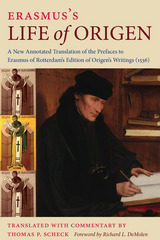 Erasmus's Life of Origen
Thomas P. Scheck
Catholic University of America Press, 2016 Erasmus of Rotterdam (1466-1536) hailed Origen of Alexandria (185-254) as a holy priest, a gifted homilist, a heroic Christian, and a celebrated exegete and theologian of the ancient Church. In this book Thomas Scheck presents one of the fruits of Erasmus's endeavors in the field of patristic studies (a particularly neglected field of scholarship within Erasmus studies) by providing the first English translation, annotated and thoroughly introduced, of Erasmus' final work, the Prefaces to his Edition of Origen's writings (1536). Originally published posthumously two months after Erasmus's death, the work surveys Origen of Alexandria's life, writings, preaching, and contribution to the Catholic Church. The staggering depth and breadth of Erasmus's learning are exhibited here, as well as the maturity of his theological reflections, which in many ways anticipate the irenicism of the Second Vatican Council with respect to Origen. Erasmus presents Origen as a marvelous doctor of the ancient Church who made a tremendous contribution to the Catholic exegetical tradition and who lived a saintly life.
Erbadistan ud Nirangistan: Facsimile Edition of the Manuscript TD
Firoze M. Kotwal
Harvard University Press, 1980 This manuscript of Avestan passages with explanations in Middle Persian gives the best text of the manual for priestly rituals in Zoroastrianism. It is a valuable source not only for the Zoroastrian religion but also for philologists interested in the Avesta language, containing Avestan passages used in the daily rituals. This text is basic to an understanding of the development of the Zoroastrian rituals over the centuries, for the Middle Persian explanations of the Avesta passages, although they may not offer great assistance to the philological interpretation of the Avestan text, do indicate how Zoroastrian priests, the guardians of the religious traditions, explained or adapted the texts to their own concepts. The difficulties of interpretation make the publication of facsimiles of manuscripts much more necessary in this linguistic area than in others.
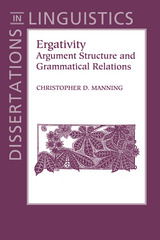 Ergativity: Argument Structure and Grammatical Relations
Christopher D. Manning
CSLI, 1996 This volume considers and examines some of the phenomena that have led languages to be considered 'ergative'. Languages considered 'ergative' have only been sparsely studied, and many fundamental questions in their analysis seem at best incompletely answered. This volume fills that void by focussing on some of the basic issues: when ergativity should be analyzed as syntactic or morphological; whether languages can be divided into two classes of syntactically and morphologically ergative languages, and if so where the division should be drawn; and whether ergative arguments are always core roles or not.
Christopher Manning's codification of syntactic approaches to dealing with ergative languages is based on a hypothesis he terms the 'Inverse Grammatical Relations hypothesis.' This hypothesis adopts a framework that decouples prominence at the levels of grammatical relations and argument structure. The result is two notions of subject: grammatical subject and argument structure subject and a uniform analysis of syntactically ergative and Philippine languages. These language groups, the syntactically ergative and Philippine languages, allow an inverse mapping in the prominence of the two highest terms between argument structure and grammatical relations. A level of argument structure is shown to be particularly well motivated by the examination of syntactically ergative languages. A study of Inuit, Tagalog, and Dyirbal shows that constraints on imperative addressee and controllee selection, antecendent of anaphors, and the controller of certain adverbial clauses are universally sensitive to argument structure. Thus, these phenomena are always accusative or neutral, explaining why passive agents and causes can generally bind reflexives. However, constraints on relativization, topicalization, focussing or questioning, specificity or wide scope, coreferential omission in coordination, etc. are shown to be universally sensitive to grammatical relations. Examining just these phenomena, which are sensitive to grammatical relations, it becomes evident that many languages are indeed syntactically ergative, and so must be countenanced by linguistic theory.
This volume combines good scholarship with innovative ideas into an important work that will appeal to a wide range of linguists and scholars.
Eric Rohmer's Film Theory (1948-1953): From 'école Scherer' to 'politique des auteurs'
Marco Grosoli
Amsterdam University Press, 2018 In the 1950s, a group of critics writing for Cahiers du Cinéma launched one of the most successful and influential trends in the history of film criticism: auteur theory. Though these days it is frequently usually viewed as limited and a bit old-fashioned, a closer inspection of the hundreds of little-read articles by these critics reveals that the movement rested upon a much more layered and intriguing aesthetics of cinema. This book is a first step toward a serious reassessment of the mostly unspoken theoretical and aesthetic premises underlying auteur theory, built around a reconstruction of Eric Rohmer's early but decisive leadership of the group, whereby he laid down the foundations for the eventual emergence of their full-fledged auteurism.
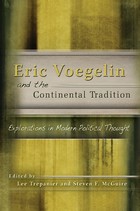 Eric Voegelin and the Continental Tradition: Explorations in Modern Political Thought
Edited by Lee Trepanier & Steven F. McGuire
University of Missouri Press, 2011 Twentieth-century political philosopher Eric Voegelin is best known as a severe critic of modernity. Much of his work argues that modernity is a Gnostic revolt against the fundamental structure of reality. For Voegelin, “Gnosticism” is the belief that human beings can transform the nature of reality through secret knowledge and social action, and he considered it the crux of the crisis of modernity. As Voegelin struggled with this crisis throughout his career, he never wavered in his judgment that philosophers of the modern continental tradition were complicit in the Gnostic revolt of modernity. But while Voegelin’s analysis of those philosophers is at times scathing, his work also bears marks of their influence, and Voegelin has much more in common with the theorists of the modern continental tradition than is usually recognized. Eric Voegelin and the Continental Tradition: Explorations in Modern Political Thought evaluates this political philosopher—one of the most original and influential thinkers of our time—by examining his relationship to the modern continental tradition in philosophy, from Kant to Derrida. In a compelling introduction, editors Lee Trepanier and Steven F. McGuire present a review of the trajectories of Voegelin’s thought and outline what often is portrayed as his derisive critique of modernity. Soon, however, they begin to unravel the similarities between Voegelin’s thought and the work of other thinkers in the continental tradition. The subsequent chapters explore these possible connections by examining Voegelin’s intellectual relationship to individual thinkers, including Hegel, Schelling, Kierkegaard, Heidegger, and Gadamer. The essays in this volume go beyond Voegelin’s own reading of the modern philosophers to offer a reevaluation of his relationship to those thinkers. In Eric Voegelin and the Continental Tradition, Voegelin’s attempt to grapple with the crisis of modernity becomes clearer, and his contribution to the modern continental tradition is illuminated. The book features the work of both established and emerging Voegelin scholars, and the essays were chosen to present thoughtful and balanced assessments of both Voegelin’s thought and the ideas of the other thinkers considered. As the first volume to examine the relationship—and surprising commonalities—between Voegelin’s philosophy and the continental tradition as a whole, this text will be of interest not only to Voegelin disciples but to philosophers engaged by continental modernism and all disciplines of political philosophy.
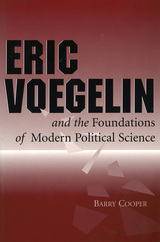 Eric Voegelin and the Foundations of Modern Political Science
Barry Cooper
University of Missouri Press, 1999 This important new work is a major analysis of the foundation of Eric Voegelin's political science. Barry Cooper maintains that the writings Voegelin undertook in the 1940s provide the groundwork for the brilliant book that is one of his best known, The New Science of Politics. At the time of that book's publication, however, few were aware of the enormous knowledge and accomplished scholarship that lay behind its illuminating, although sometimes baffling, formulations. By focusing on several of the key chapters in Voegelin's eight- volume History of Political Ideas, especially the studies of Bodin, Vico, and Schelling, Cooper shows how those studies provide the basis for Voegelin's thought. Investigating Voegelin's study of Oriental influences on Western political "ideas," especially Mongol constitutional law, and his study of Toynbee, Cooper seeks to demonstrate the vast range of materials Voegelin used. Cooper contends that, as with other great thinkers, political crisis, specifically the world war of 1939-1945, stimulated Voegelin's intellectual and spiritual achievement. He provides an analysis of Voegelin's immediate concern with the course of World War II, his ability to understand those dramatic events in a large context, and his ability to provide an insightful account of the causes, the significance, and the consequences of the spiritual and political disorder that was evident all around him. In Eric Voegelin and the Foundations of Modern Political Science, Cooper makes the connection between Voegelin's political writings of the 1940s and the meditative interpretations that began to appear with the publication of Anamnesis and with the later volumes of Order and History much more intelligible than does any existing discussion of Voegelin. Scholars in intellectual history and political science will benefit enormously from this valuable new addition to Voegelin studies.
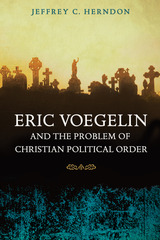 Eric Voegelin and the Problem of Christian Political Order
Jeffrey C. Herndon
University of Missouri Press, 2007
Although some critics of Eric Voegelin’s later work have faulted his failure to deal with the historical Jesus and to address the implications of Christianity for social and political life, the recent publication of Voegelin’s History of Political Ideas has allowed a more complete assessment of his position regarding the Christian political order. This book addresses that criticism through an analysis of Voegelin’s early work.
In Eric Voegelin and the Problem of Christian Political Order, Jeffrey C. Herndon analyzes the development of Voegelin’s thought regarding the origins of Christianity in the person of Jesus, the development of the church in the works of Paul, and the relationship between an immanent institutional order symbolizing the divine presence and the struggle for social and political order. Focusing on the tension between a spiritual phenomenon based on Pauline faith and the institutionalization of that experience in the church, Herndon offers one of the first examinations of the relationship of the History of Political Ideas to Voegelin’s larger body of work.
In his wide-ranging study, Herndon explores Voegelin’s examination of the problem of Christian political order from the inception of Christianity through the Great Reformation. He also presents a clarification of Voegelin’s theory of civilizational foundation and of Voegelin’s philosophy of history with regard to Christianity and Western political order.
Herndon addresses not only the nagging problem in Voegelin scholarship regarding his relationship with the historical Jesus but also the “Pauline compromises with the world” that enabled Christianity to become the instrument by which the West was civilized. He also shows that Voegelin’s interpretation of the historical pressures released by the Great Reformation is important to an understanding of his later work regarding the negative effect of Christian symbols in the creation of ideological disorder.
Eric Voegelin and the Problem of Christian Political Order clarifies issues in Voegelin studies regarding the intersection between political theory and Christian concerns, addressing the relation of religious experience to the public sphere of political life in the West and helping to explain Voegelin’s contention that the death of the spirit is the price of progress. It offers scholars a perspective heretofore lacking in Voegelin scholarship and a clearer view of Voegelin’s understanding of the Christian dispensation and its influence on the course of Western development, history, and philosophy.
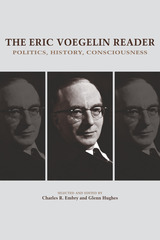 The Eric Voegelin Reader: Politics, History, Consciousness
Charles R. Embry
University of Missouri Press, 2023 By the time Eric Voegelin fled Hitler’s regime and made his way to the United States in 1938, he had already written four books criticizing Nazi racism, establishing what would be the focus of his life’s work: to account for the endemic political violence of the twentieth century. One of the most original political philosophers of the period, Voegelin has largely avoided ideological labels or categorizations of his work. Because of this, however, and because no one work or volume of his can do justice to his overall project, his work has been seen as difficult to approach.
Drawing from the University of Missouri Press’s thirty-four-volume edition of The Collected Works of Eric Voegelin (1990-2009), Charles Embry and Glenn Hughes have assembled a selection of representative works of Voegelin, satisfying a longstanding need for a single volume that can serve as a general introduction to Voegelin’s philosophy. The collection includes writings that demonstrate the range and creativity of Voegelin’s thought as it developed from 1956 until his death in 1985 in his search for the history of order in human society.
The Reader begins with excerpts from Autobiographical Reflections (1973), which include an orienting mixture of biographical information, philosophical motivations, and the scope of Voegelin’s project. It reflects key periods of Voegelin’s philosophical development, pivoting on his flight from the Gestapo.
The next section focuses on Voegelin’s understanding of the contemporary need to re-ground political science in a non-positivistic, post-Weberian outlook and method. It begins with Voegelin’s historical survey of science and scientism, followed by his explanation of what political science now requires in his introduction to The New Science of Politics. Also included are two essays that exemplify the practice of this “new science.” Voegelin started his academic career as a political scientist, and these early essays indicate his wide philosophical vision.
Voegelin recognized that a fully responsible “new science of politics” would require the development of a philosophy of history. This led to the writing of his magnum opus, the five-volume Order and History (1956–1985). This section of the Reader includes his introductions to volumes 1, 2 and 4 and his most essential accounts of the theoretical requirements and historical scope of a philosophy of history adequate to present-day scholarship and historical discoveries.
In the course of his career, Voegelin came to understand that political science, political philosophy, and philosophy of history must have as their theoretical nucleus a sound philosophical anthropology based on an accurate philosophy of human consciousness. The next set of writings consists of one late lecture and four late essays that exemplify how Voegelin recovers the wisdom of classical philosophy and the Western religious tradition while criticizing modern misrepresentations of consciousness. The result is Voegelin’s contemporary accounts of the nature of reason, the challenge of truly rational discussion, and the search for divine origins and the life of the human spirit.
During his philosophical journey, Voegelin addressed the historical situatedness of human existence, explicating the historicity of human consciousness in a manner that gave full due to the challenges of acknowledging both human immersion in the story of history and the ability of consciousness to arrive at philosophically valid truths about existence that are transhistorical. The essays in this final section present the culmination of his philosophical meditation on history, consciousness, and reality.
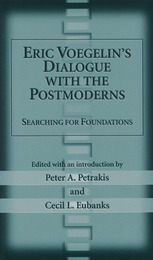 Eric Voegelin's Dialogue with the Postmoderns: Searching for Foundations
Edited & Intro by Peter A. Petrakis & Cecil L. Eubanks
University of Missouri Press, 2004 This collection of essays endeavors to generate a dialogue between Eric Voegelin and other prominent twentieth-century thinkers and explore some of the more perplexing issues in contemporary political theory. Each essay rests on the underlying question: is it possible or desirable to construct or discover political foundations without resorting to metaphysical or essentialist constructs? The introduction focuses on the two nineteenth-century thinkers, Nietzsche and Husserl, who have framed the debate about modernity and postmodernity; thereafter, the book examines Voegelin's ideas as compared to those of other twentieth-century thinkers. Discussed within the volume are Levinas and the precedence of ethics, Ricoeur's theory of narrative representation, Deleuze and the philosophy of immanence, Voegelin's relationship to a speech- dimension theory of human behavior, and Patocka's theory of pre- metaphysical transcendence in Socrates. What will impress scholars most about this collection is the provocative dialogue created between Voegelin and other major thinkers of postmodernism that addresses the issue of establishing foundations without foundationalism.
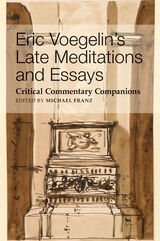 Eric Voegelin's Late Meditations and Essays: Critical Commentary Companions
Michael Franz
St. Augustine's Press, 2023 Eric Voegelin (1901–1985) is widely regarded as one of the greatest political philosophers of the 20th century, yet adequate understanding of his writings stands as a challenge for current and future generations. Voegelin’s thought continued to develop at a rapid pace during the last two decades of his life, and as Ellis Sandoz has written, his work found “not only its final but its most profound expression” during this period. Voegelin’s fame stemmed mostly from his many books and the laudatory review articles published in response to them, but he was “preeminently an essayist,” as Sandoz observes. The meditative analyses and essays written in the culminating phase of Voegelin’s career not only expand and deepen his work as a whole, but also revise central components of it in ways that compel reconsideration of even his most widely read texts.
Voegelin’s books gave rise to a vast secondary literature that continues to grow, yet the exceptionally impactful late essays and meditative works have never received the scholarly commentaries they deserve because they were published originally as journal articles or chapters in edited collections. This volume remedies that shortcoming with 14 critical analyses that elucidate the late essays while also addressing their implications for the entirety of Voegelin’s thought. The commentaries will prove invaluable to students and scholars in political science, philosophy, history, theology, and other disciplines, serving as a companion piece to the singularly important Vol. 12 of Voegelin’s Collected Works, Published Essays 1966–1985.
Eric Warburg: A Transatlantic Life
Jeanette Erazo Heufelder
Haus Publishing, 2025 A comprehensive telling of the life of Eric Warburg, nephew of the art historian Aby Warburg.
In Eric Warburg, Jeanette Erazo Heufelder tells the story of the nephew of the art historian Aby Warburg, whose world-famous library Eric saved from the Nazis. He was a Jew, a banker, a helper of escapees, an intelligence officer in the US Army, a transatlantic bridge builder, and a Cold Warrior. With the help of the cooperation channels he set up, West German and US social groups were aligned with the West amidst the turmoil of postwar Europe.
The history of the transatlantic partnership has become highly topical; since the Russian invasion of Ukraine on February 24, 2022, it has been invoked in Europe as a key reassurance. Eric Warburg’s life, and that of Aby Warburg’s library, tells the story of Europe's twentieth century, the legacy of which continues to inform and inspire the transatlantic partnership today.
 Erich Fromm and Critical Criminology: Beyond the Punitive Society
Edited by Kevin Anderson and Richard Quinney
University of Illinois Press, 2000 Linking the writings of the great humanist psychologist Erich Fromm to criminology, this collection shows how viewing crime patterns and the criminal justice system from Fromm's humanist perspective opens a path to more effective and more humane ways of understanding and dealing with crime and criminals. Contributors to Erich Fromm and Critical Criminology draw on Fromm's writings on alienation, sadomasochism, and patriarchal/matriarchal values to assess the kinds of crimes being committed and the kinds of people committing them. They explore the spiritual and intellectual sources of Fromm's thought--including Jewish theology, Freudian psychoanalysis, Marxism, and Buddhism--and demonstrate how his socialist humanism points toward a society free of crime and violence. This volume also includes translations of two of Fromm's early articles on criminal justice, never before available in English, in which he develops a psychoanalytic Marxist critique of the role of criminal justice in a class society. At a time when American society seems bent, to an unprecedented degree, on imprisonment, executions, and other violent responses to the problem of crime, Fromm's humanist critique offers a unique vantage point from which to renew and develop a critical criminology.
 Erich Przywara, S.J.: His Theology and His World
Thomas F. O’Meara, O.P.
University of Notre Dame Press, 2002
"O'Meara masterfully situates Pryzwara in relation to the traditional and contemporary theological, philosophical, ecclesial, cultural, and social contexts within which he wrote." --William P. Loewe, professor of religious studies, Catholic University of America
Erich Przywara, S.J. (1889-1972) is one of the important Catholic intellectuals of the twentieth century. Yet, in the English-speaking world Przywara remains largely unknown. Few of his sixty books or six hundred articles have been translated. In this engaging new book, Thomas O'Meara offers a comprehensive study of the German Jesuit Erich Przywara and his philosophical theology. Przywara's scholarly contributions were remarkable. He was one of three theologians who introduced the writings of John Henry Cardinal Newman into Germany. From his position at the Jesuit journal in Munich, Stimmen der Zeit, he offered an open and broad Catholic perspective on the cultural, philosophical, and theological currents of his time. As one of the first Catholic intellectuals to employ the phenomenologies of Edmund Husserl and Max Scheler, he was also responsible for giving an influential, more theological interpretation of the Spiritual Exercises of Ignatius Loyola. Przywara was also deeply engaged in the ideas and authors of his times. He was the first Catholic dialogue partner of Karl Barth and Paul Tillich. Edmund Husserl was counted among Przywara's friends, and Edith Stein was a close personal and intellectual companion. Through his interactions with important figures of his age and his writings, ranging from speculative systems to liturgical hymns, Przywara was of marked importance in furthering a varied dialogue between German Catholicism and modern culture.
Following a foreword by Michael Fahey, S.J., O'Meara presents a chapter on Pryzwara's life and a chronology of his writings. O'Meara then discusses Pryzwara's philosophical theology, his lecture-courses at German universities on Augustine and Aquinas, his philosophy of religion, and his influence on important intellectual contemporaries. O'Meara concludes with an in-depth analysis of Pryzwara's theology, focusing particularly on his Catholic views of person, liturgy, and church.
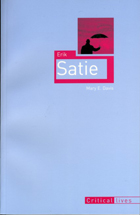 Erik Satie
Mary E. Davis
Reaktion Books, 2007 A composer who dabbled in the Dada movement, a Bohemian “gymnopédiste” of fin-de-siècle Montmartre, and a legendary dresser known as “The Velvet Gentleman,” Erik Satie cut a unique figure among early twentieth-century European composers. Yet his legacy has largely languished in the shadows of Stravinsky, Debussy, and Ravel. Mary E. Davis now brings Satie to life in this fascinating new biography. Satie redefined the composer’s art, devising new methods of artistic expression that melded ordinary and rarified elements of words, visual art, and music. Davis argues that Satie’s modernist aesthetic was grounded in the contradictions of his life—such as enrolling in the conservative Schola Cantorum after working as a cabaret performer—and is reflected in his irreverent essays, drawn art, and music. Erik Satie explores how the composer was embraced by avant-garde artists and fashionable Parisian elite, and how his experiences inspired him to create the musical style of Neoclassicism. Satie also employed the power of the image through his infamous fashion statements, Davis contends, and became part of a nascent celebrity culture. A cogent and informative portrait, Erik Satie upends the accepted history of modernist music and restores the composer to his rightful pioneering status.
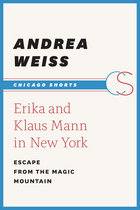 Erika and Klaus Mann in New York: Escape from the Magic Mountain
Andrea Weiss
University of Chicago Press, 2008 This is the riveting tale of two brave nonconformists whose dramatic lives open up new perspectives on the history of the twentieth century. Thomas Mann’s two eldest children, Erika and Klaus, were unconventional, rebellious, and fiercely devoted to each other. Empowered by their close bond, they espoused vehemently anti-Nazi views in a Europe swept up in fascism and were openly, even defiantly, gay in an age of secrecy and repression. In 1936, they fled to the United States and chose New York as their new adopted home. From the start, the two were embroiled by the literary and intellectual life, political turmoil, and shifting sexual mores of their times. Andrea Weiss engages their struggles, their friendships (Maurice Wertheim and Annemarie Schwarzenbach, among them), and their liaisons, as the siblings try to adapt to their new lives, all while introducing their work to an American audience for the first time.
 Erin and Iran: Cultural Encounters between the Irish and the Iranians
H. E. Chehabi
Harvard University Press, 2015 In Erin and Iran, ten essays by North American and European scholars discuss parallel themes in and interactions between Irish and Iranian cultures. In the first section three essays explore common elements in pre-Christian Irish and pre-Islamic Iranian mythologies, common elements that have often been pointed out by scholars of Indo-European mythology but rarely examined in detail. In the following section four essays address literary subjects, ranging from medieval romances such as Tristan and Isolde and Vis and Ramin to twentieth-century novels such as James Joyce’s Ulysses and Simin Daneshvar’s Savushun. In the last section three nineteenth-century travelogues are presented, two written by Irish travelers to Iran and one written by an Indo-Persian traveler to Ireland. Together, these studies constitute the first-ever collection of articles dealing with cultural encounters between the Irish and the Iranians.
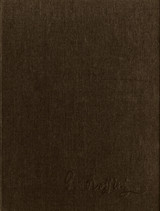 Ermione: Dramma per musica in Two Acts by Andrea Leone Tottola
Gioachino Rossini
University of Chicago Press, 1996 Ermione is one of the extraordinary serious operas that Rossini composed while artistic director of the royal theaters of Naples. Although it was not originally successful, Rossini treasured Ermione as his "little William Tell." Its revival at the Rossini Opera Festival's production in 1987—the first since the original staging in 1819—revealed its beauty to modern audiences and has spurred many additional performances.
This critical edition is the first publication of Ermione in full score.
The originality and power of Rossini's score lie in the musical realization of the four principal characters in Tottola's libretto—four survivors of the Trojan war—based on Racine's tragedy Andromaque. Rossini's Ermione was one of the most fully developed characters in nineteenth-century opera. The work's musical structure also was unconventional for its day. All the solo numbers involve other characters, and there is only one scene for a single protagonist.
 Ernest Gruening and the American Dissenting Tradition
Robert David Johnson
Harvard University Press, 1998 Ernest Gruening is perhaps best known for his vehement fight against U.S. military involvement in Vietnam, where he set himself apart by casting one of two votes against the Tonkin Gulf Resolution in 1964. However, as Robert Johnson shows in this political biography, it's Gruening's sixty-year public career in its entirety that provides an opportunity for historians to explore continuity and change in dissenting thought, on both domestic and international affairs, in twentieth-century America.
Gruening's outlook on domestic affairs took shape in the intellectual milieu of Progressive-era Boston, where he first devoted attention to foreign affairs in crusades against aggressive U.S. policies toward Haiti and Mexico. In the late 1920s, he was appointed editor of a reform newspaper in Portland, Maine, and moved from there to The Nation. By the early 1930s he had built a national reputation as an expert on Latin American affairs, prompting Franklin Roosevelt to appoint him chief U.S. policymaker for Puerto Rico. In 1939, Roosevelt named Gruening governor of Alaska, where for fourteen years he played a key role in the political development of the territory. In 1958 Alaskan voters elected him to the U.S. Senate, where he articulated a dissenting outlook in inter-American affairs, foreign aid policy, and the relationship between the federal government, the economy, and the issue of monopoly.
Throughout his life, Gruening struggled to reconcile his ideological perspective, which drew on dissenting ideas long embedded in American history, with a desire for political effectiveness.
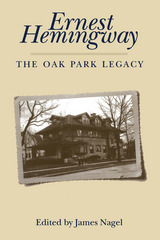 Ernest Hemingway: The Oak Park Legacy
James Nagel
University of Alabama Press, 1996 Ernest Hemingway: The Oak Park Legacy is the first extensive examination of the relationship of Hemingway to his hometown, Oak Park, Illinois, and the influence its people, places, and underlying values had on his early work. In this volume, 11 leading Hemingway scholars explore various aspects of these issues, from the migration of the Hemingway family from Connecticut to Illinois in the 1850s, to Hemingway's high-school stories and the dramatic breakthrough of In Our Time and The Sun Also Rises. With these books, Hemingway suddenly became one of the most influential writers of the 20th century. The essays in this collection explore the social and family background that provided the material and sensibility for these literary masterpieces.
In these essays, James Nagel provides the first account ever published of the move of the Hemingway family from Connecticut to Illinois. Writing his account after the discovery of a lost diary by one of Hemingway's ancestors, Nagel explores dates and places, the motivation for the move to the Midwest, and the tragedies that awaited the family there, including the death of two young men in the Civil War. Michael Reynolds, the premiere biographer of Ernest Hemingway, describes the culture of the village of Oak Park at the turn of the century, and Larry E. Grimes presents an important new assessment of the religious training the Hemingway children received. David Marut discusses the short stories Hemingway published while still a highschool student, and Carlos Azevedo, Mary Anne O'Neal, Abby H. P. Werlock, and George Monteiro examine the early stories about Nick Adams. In an insightful afterword, Morris Buske, the Historian of the Ernest Hemingway Foundation of Oak Park, reflects on the differing values of Ernest Hemingway's parents, the artistic, cultured Hall family as opposed to the scientific, more practical Hemingways, charting the influence the two traditions had on the young Ernest.
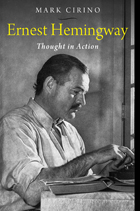 Ernest Hemingway: Thought in Action
Mark Cirino
University of Wisconsin Press, 2012 Ernest Hemingway’s groundbreaking prose style and examination of timeless themes made him one of the most important American writers of the twentieth century. Yet in Ernest Hemingway: Thought in Action, Mark Cirino observes, “Literary criticism has accused Hemingway of many things but thinking too deeply is not one of them.” Although much has been written about the author’s love of action—hunting, fishing, drinking, bullfighting, boxing, travel, and the moveable feast—Cirino looks at Hemingway’s focus on the modern mind, paralleling the interest in consciousness of such predecessors and contemporaries as Proust, Joyce, Woolf, Faulkner, and Henry James. Hemingway, Cirino demonstrates, probes the ways his character’s minds respond when placed in urgent situations or when damaged by past traumas.
In Cirino’s analysis of Hemingway’s work through this lens—including such celebrated classics as A Farewell to Arms, The Old Man and the Sea, and “Big Two-Hearted River” and less-appreciated works including Islands in the Stream and “Because I Think Deeper”—an entirely different Hemingway hero emerges: intelligent, introspective, and ruminative.
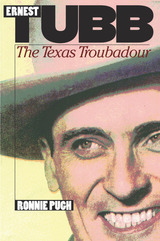 Ernest Tubb: The Texas Troubadour
Ronnie Pugh
Duke University Press, 1996 In this definitive biography of Ernest Tubb, Ronnie Pugh brings one of country music’s greatest performers back to center stage. Tracing a career that began in the 1930s and continued until just a few years before Tubb’s death in 1984, Pugh presents not only the long and legendary life of the Texas Troubadour but also an unparalleled view of the world of country music in which Ernest Tubb played an essential part.
Tubb began his career as an imitator of Jimmie Rodgers, but stormed the country music scene in the 1940s with a new honky tonk sound and a string of hits that included “Walking the Floor Over You.” His innovations marked an important transition in country music to a style and lyric in tune with modern American working people, or at least that offered the real-life themes of hard drinking, divorce, tough times, and ruined lives—changes that helped define the music we recognize today as “country.” A member of the Grand Ole Opry until 1982, Tubb hosted a live radio broadcast from the Ernest Tubb Record Shop in Nashville for years and became one of the first country music stars to host his own television show in the mid-1960s. Always popular and on the road much of the time even after his prime hit-making years had ended, he was well-known for promoting the careers of many new performers on the rise.
Delving into fan club journals, songbooks, newspaper broadcast logs, record company files, and hundreds of interviews, Ronnie Pugh draws a picture of Tubb—exploring both his personal and professional life—that is unprecedented in its intimacy, detail, and vitality. We get a close-up view of Tubb riding the crest of his popularity, setting the pace for Nashville, facing the onslaught of Elvis Presley and rock ’n roll, and surviving as a country music legend. Richly illustrated with almost a hundred photographs, many of which are rare unpublished shots from private collections, Ernest Tubb also contains a detailed and complete sessionography, a resource that will be of continuing importance for serious record collectors.
A biography that has been long awaited from Ronnie Pugh, unquestionably the leading authority on Ernest Tubb, this book will delight readers from among the fans of country music, those interested in the history of country music or American popular music and culture generally, and, of course, Ernest Tubb fans.
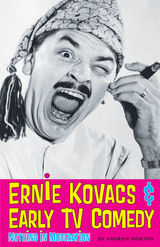 Ernie Kovacs & Early TV Comedy: Nothing in Moderation
By Andrew Horton
University of Texas Press, 2010 Among the pioneers of television, Ernie Kovacs was one of the most original and imaginative comedians. His zany, irreverent, and surprising humor not only entertained audiences throughout the 1950s and early 1960s, but also inspired a host of later comedies and comedians, including Monty Python, David Letterman, much of Saturday Night Live, Rowan and Martin's Laugh-In, Captain Kangaroo, and even Sesame Street. Kovacs created laughter through wildly creative comic jokes, playful characterizations, hilarious insights, and wacky experiments. "Nothing in moderation," his motto and epitaph, sums up well Kovacs's wholehearted approach to comedy and life. In this book, Andrew Horton offers the first sustained look at Ernie Kovacs's wide-ranging and lasting contributions to the development of TV comedy. He discusses in detail Kovacs's work in New York, which included The Ernie Kovacs Show (CBS prime time 1952–1953), The Ernie Kovacs Show (NBC daytime variety 1956–1957), Tonight (NBC late-night comedy/variety 1956-1957), and a number of quiz shows. Horton also looks at Kovacs's work in Los Angeles and in feature film comedy. He vividly describes how Kovacs and his comic co-conspirators created offbeat characters and zany situations that subverted expectations and upended the status quo. Most of all, Horton demonstrates that Kovacs grasped the possibility for creating a fresh genre of comedy through the new medium of television and exploited it to the fullest.
Ernst Cassirer
Seymour W. Itzkoff
University of Notre Dame Press, 1997
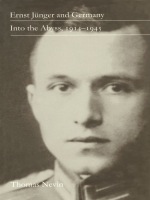 Ernst Jünger and Germany: Into the Abyss, 1914-1945
Thomas R. Nevin
Duke University Press, 1996 For most of his life, Ernst Jünger, one of Europe's leading twentieth-century writers, has been controversial. Renowned as a soldier who wrote of his experience in the First World War, he has maintained a remarkable writing career that has spanned five periods of modern German history. In this first comprehensive study of Jünger in English, Thomas R. Nevin focuses on the writer’s first fifty years, from the late Wilhelmine era of the Kaiser to the end of Hitler’s Third Reich. By addressing the controversies and contradictions of Jünger, a man who has been extolled, despised, denounced, and admired throughout his lifetime, Ernst Jünger and Germany also opens an uncommon view on the nation that is, if uncomfortably, represented by him.
Ernst Jünger is in many ways Germany’s conscience, and much of the controversy surrounding him is at its source measured by his relation to the Nazis and Nazi culture. But as Nevin suggests, Jünger can more specifically and properly be regarded as the still living conscience of a Germany that existed before Hitler. Although his memoir of service as a highly decorated lieutenant in World War I made him a hero to the Nazis, he refused to join the party. A severe critic of the Weimar Republic, he has often been denounced as a fascist who prepared the way for the Reich, but in 1939 he published a parable attacking despotism. Close to the men who plotted Hitler’s assassination in 1944, he narrowly escaped prosecution and death. Drawing largely on Jünger’s untranslated work, much of which has never been reprinted in Germany, Nevin reveals Jünger’s profound ambiguities and examines both his participation in and resistance to authoritarianism and the cult of technology in the contexts of his Wilhelmine upbringing, the chaos of Weimar, and the sinister culture of Nazism.
Winner of Germany’s highest literary awards, Ernst Jünger is regularly disparaged in the German press. His writings, as this book indicates, put him at an unimpeachable remove from the Nazis, but neo-Nazi rightists in Germany have rushed to embrace him. Neither apology, whitewash, nor vilification, Ernst Jünger and Germany is an assessment of the complex evolution of a man whose work and nature has been viewed as both inspiration and threat.
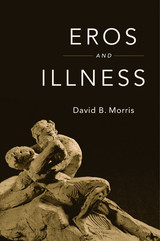 Eros and Illness
David B. Morris
Harvard University Press, 2017 Susan Sontag once described illness as “the night-side of life.” When we or our loved ones fall ill, our world is thrown into darkness and disarray, our routines are interrupted, our deepest beliefs shaken. The modern regime of hyper-logical biomedicine offers little solace when it comes to the effects of ill health on our inner lives. By exploring the role of desire in illness, Eros and Illness offers an alternative: an unconventional, deeply human exploration of what it means to live with, and live through, disease.
When we face down illness, something beyond biomedicine’s extremely valuable advances in treatment and prevention is sorely needed. Desire in its many guises plays a crucial part in illness, David Morris shows. Emotions, dreams, and stories—even romance and eroticism—shape our experiences as patients and as caregivers. Our perception of the world we enter through illness—including too often a world of pain—is shaped by desire.
Writing from his own heartbreaking experience as a caretaker for his wife, Morris relates how desire can worsen or, with care, mitigate the heavy weight of disease. He looks to myths, memoirs, paintings, performances, and narratives to understand how illness is intertwined with the things we value most dearly. Drawing on cultural resources from many centuries and media, Eros and Illness reaches out a hand to guide us through the long night of illness, showing us how to find productive desire where we expected only despair and defeat.
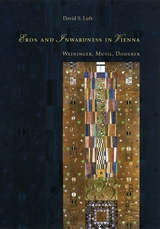 Eros and Inwardness in Vienna: Weininger, Musil, Doderer
David S. Luft
University of Chicago Press, 2003 Although we usually think of the intellectual legacy of twentieth-century Vienna as synonymous with Sigmund Freud and his psychoanalytic theories, other prominent writers from Vienna were also radically reconceiving sexuality and gender. In this probing new study, David Luft recovers the work of three such writers: Otto Weininger, Robert Musil, and Heimito von Doderer. His account emphasizes the distinctive intellectual world of liberal Vienna, especially the impact of Schopenhauer and Nietzsche in this highly scientific intellectual world.
According to Luft, Otto Weininger viewed human beings as bisexual and applied this theme to issues of creativity and morality. Robert Musil developed a creative ethics that was closely related to his open, flexible view of sexuality and gender. And Heimito von Doderer portrayed his own sexual obsessions as a way of understanding the power of total ideologies, including his own attraction to National Socialism. For Luft, the significance of these three writers lies in their understandings of eros and inwardness and in the roles that both play in ethical experience and the formation of meaningful relations to the world-a process that continues to engage artists, writers, and thinkers today.
Eros and Inwardness in Vienna will profoundly reshape our understanding of Vienna's intellectual history. It will be important for anyone interested in Austrian or German history, literature, or philosophy.
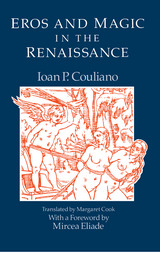 Eros and Magic in the Renaissance
Ioan P. Couliano
University of Chicago Press, 1987 It is a widespread prejudice of modern, scientific society that "magic" is merely a ludicrous amalgam of recipes and methods derived from primitive and erroneous notions about nature. Eros and Magic in the Renaissance challenges this view, providing an in-depth scholarly explanation of the workings of magic and showing that magic continues to exist in an altered form even today.
Renaissance magic, according to Ioan Couliano, was a scientifically plausible attempt to manipulate individuals and groups based on a knowledge of motivations, particularly erotic motivations. Its key principle was that everyone (and in a sense everything) could be influenced by appeal to sexual desire. In addition, the magician relied on a profound knowledge of the art of memory to manipulate the imaginations of his subjects. In these respects, Couliano suggests, magic is the precursor of the modern psychological and sociological sciences, and the magician is the distant ancestor of the psychoanalyst and the advertising and publicity agent.
In the course of his study, Couliano examines in detail the ideas of such writers as Giordano Bruno, Marsilio Ficino, and Pico della Mirandola and illuminates many aspects of Renaissance culture, including heresy, medicine, astrology, alchemy, courtly love, the influence of classical mythology, and even the role of fashion in clothing.
Just as science gives the present age its ruling myth, so magic gave a ruling myth to the Renaissance. Because magic relied upon the use of images, and images were repressed and banned in the Reformation and subsequent history, magic was replaced by exact science and modern technology and eventually forgotten. Couliano's remarkable scholarship helps us to recover much of its original significance and will interest a wide audience in the humanities and social sciences.
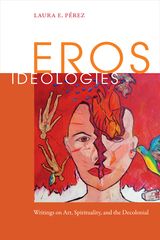 Eros Ideologies: Writings on Art, Spirituality, and the Decolonial
Laura E. Pérez
Duke University Press, 2018 In Eros Ideologies Laura E. Pérez explores the decolonial through Western and non-Western thought concerning personal and social well-being. Drawing upon Jungian, people-of-color, and spiritual psychology alongside non-Western spiritual philosophies of the interdependence of all life-forms, she writes of the decolonial as an ongoing project rooted in love as an ideology to frame respectful coexistence of social and cultural diversity. In readings of art that includes self-portraits by Frida Kahlo, Ana Mendieta, and Yreina D. Cervántez, the drawings and paintings of Chilean American artist Liliana Wilson, and Favianna Rodriguez's screen-printed images, Pérez identifies art as one of the most valuable laboratories for creating, imagining, and experiencing new forms of decolonial thought. Such art expresses what Pérez calls eros ideologies: understandings of social and natural reality that foreground the centrality of respect and care of self and others as the basis for a more democratic and responsible present and future. Employing a range of writing styles and voices—from the poetic to the scholarly—Pérez shows how art can point to more just and loving ways of being.
Eros, Magic, and the Murder of Professor Culianu
Ted Anton
Northwestern University Press, 1996 Winner of 1997 Carl Sandburg Award On May 21, 1991, University of Chicago professor Ioan Culianu was murdered execution-style on campus. The crime stunned the school, terrified students, and mystified the FBI. The case remains unsolved. In Eros, Magic, and the Murder of Professor Culianu, award-winning investigative reporter Ted Anton shows that the murder is what Culianu's friends suspected all along: the first political assassination of a professor on American soil.
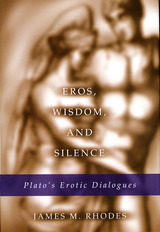 Eros, Wisdom, and Silence: Plato's Erotic Dialogues
James M. Rhodes
University of Missouri Press, 2003 Eros, Wisdom, and Silence is a close reading of Plato’s Seventh Letter and his dialogues Symposium and Phaedrus, with significant attention also given to Alcibiades I. A book about love, James Rhodes’s work was conceived as a conversation and meant to be read side by side with Plato’s works and those of his worthy interlocutors. It invites lovers to participate in conversations that move their souls to love, and it also invites the reader to take part in the author’s dialogues with Plato and his commentators. Rhodes addresses two closely related questions: First, what does Plato mean when he says in the Seventh Letter that he never has written and never will write anything concerning that about which he is serious? Second, what does Socrates mean when he claims to have an art of eros and that this techne is the only thing he knows? Through careful analysis, Rhodes establishes answers to these questions. He determines that Plato cannot write anything concerning that about which he is serious because his most profound knowledge consists of his soul’s silent vision of ultimate, transcendent reality, which is ineffable. Rhodes also shows that, for Socrates, eros is a symbol for the soul’s experience of divine reality, which pulls every element of human nature toward its proper end, but which also leads people to evil and tyranny when human resistance causes it to become diseased. Opening up a new avenue of Plato scholarship, Eros, Wisdom, and Silence is political philosophy at its conversational best. Scholars and students in political philosophy, classical studies, and religious studies will find this work invaluable.
 Erosion: American Environments and the Anxiety of Disappearance
Gina Caison
Duke University Press, 2024 In Erosion, Gina Caison traces how American authors and photographers have grappled with soil erosion as a material reality that shapes narratives of identity, belonging, and environment. Examining canonical American texts and photography, including John Steinbeck's The Grapes of Wrath, Octavia Butler’s Parable series, John Audubon’s Louisiana writings, and Dorothea Lange’s Migrant Mother, Caison shows how concerns over erosion reveal anxieties of disappearance that are based in the legacies of settler colonialism. Soil loss not only occupies a complex metaphorical place in the narrative of American identity; it becomes central to preserving the white settler colonial state through Indigenous dispossession and erasure. At the same time, Caison examines how Indigenous texts and art such as Lynn Riggs's play Green Grow the Lilacs, Karenne Wood’s poetry, and Monique Verdin's photography challenge colonial narratives of the continent by outlining the material stakes of soil loss for their own communities. From California to Oklahoma to North Carolina’s Outer Banks, Caison ultimately demonstrates that concerns over erosion reverberate into issues of climate change, land ownership, Indigenous sovereignty, race, and cultural and national identity.
The Erosion of Childhood
Valerie Polakow
University of Chicago Press, 1992 How can child care be structured to protect both the interests of children and the rights of women? Must children suffer the "loss" of their childhood through institutional care? Polakow uses her observations of pre-school centers—including profit-run, federally funded, community, and Montessori institutions—to open the "windows of daycare."
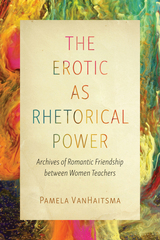 The Erotic as Rhetorical Power: Archives of Romantic Friendship between Women Teachers
Pamela VanHaitsma
Ohio State University Press, 2024 The Erotic as Rhetorical Power offers a queer feminist history of rhetoric that recovers the civic contributions of women teachers in same-sex romantic friendships. Extending perspectives from ancient rhetoric to nineteenth-century progressivism, from Audre Lorde’s Black lesbian feminist theory to its present-day uptakes, Pamela VanHaitsma conceives of the erotic as an interanimation of desires that, in being passionately shared, becomes imbued with the power to forge connection and foment change. VanHaitsma’s theory of the erotic as rhetorical power emerges from both historiographic and imaginative engagements with more than twenty archives of romantic friendships between women: Sallie Holley and Caroline Putnam, Irene Leache and Anna Wood, Gertrude Buck and Laura Wylie, and Rebecca Primus and Addie Brown. VanHaitsma considers how even as the erotic in these romantic friendships fueled the women’s rhetorical activities toward transformational ends—whether working toward the abolition of slavery, greater educational access, or voting rights—it also energized rhetorical activities that sometimes challenged but also reinforced troubling power dynamics. The Erotic as Rhetorical Power uncovers the erotic’s significance as a conflicted site of power that is central to rhetorical theory and history as well as feminist and LGBTQ+ studies.
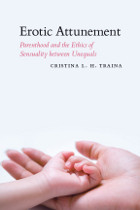 Erotic Attunement: Parenthood and the Ethics of Sensuality between Unequals
Cristina L. H. Traina
University of Chicago Press, 2011 Heightened awareness of the problem of sexual abuse has led to deep anxiety over adults touching children—in nearly any context. Though our society has moved toward increasingly strict enforcement of this taboo, studies have shown that young children need regular human contact, and the benefits of breastfeeding have been widely extolled. Exploring the complicated history of love, desire, gender, sexuality, parenthood, and inequality, Erotic Attunement probes the disquieting issue of how we can draw a clear line between natural affection toward children and perverse exploitation of them.
Cristina L. H. Traina demonstrates that we cannot determine what is wrong about sexual abuse without first understanding what is good about appropriate sensual affection. Pondering topics such as the importance of touch in nurturing children, the psychology of abuse and victimhood, and recent ideologies of motherhood, she argues that we must expand our philosophical and theological language of physical love and make a distinction between sexual love and erotic love. Taking on theological and ethical arguments over the question of sexuality between unequals, she arrives at the provocative conclusion that it can be destructive to completely bar eroticism from these relationships.
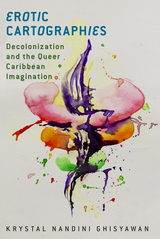 Erotic Cartographies: Decolonization and the Queer Caribbean Imagination
Krystal Nandini Ghisyawan
Rutgers University Press, 2022 Erotic Cartographies uses subjective mapping, a participatory data collection technique, to demonstrate how Trinidadian same-sex-loving women use their gender performance, erotic autonomy, and space-making practices to reinforce and resist colonial ascriptions on subject bodies. The women strategically embody their sexual identities to challenge imposed subject categories and to contest their invisibility and exclusion from discourses of belonging. Erotic Cartographies refers to the processes of mapping territories of self-knowing and self-expression, both cognitively in the imagination and on paper during the mapping exercise, exploring how meaning is given to space, and how it is transformed. Using the women’s quotes and maps, the book focuses on the false binary of public-private, the practices of home and family, and religious nationalism and spiritual self-seeking, to demonstrate the women’s challenges to the structural, symbolic, and interpersonal violence of colonial discourses and practices related to gender, knowledge, and power in Trinidadian society.
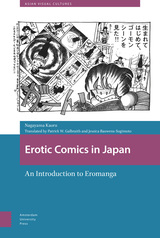 Erotic Comics in Japan: An Introduction to Eromanga
Patrick Galbraith
Amsterdam University Press, 2021 Comics and cartoons from Japan, or manga and anime, are an increasingly common feature of visual and popular culture around the world. While it is often observed that these media forms appeal to broad and diverse demographics, including many adults, eroticism continues to unsettle critics and has even triggered legal action in some jurisdictions. It is more urgent than ever to engage in productive discussion, which begins with being informed about content that is still scarcely understood outside small industry and fan circles. Erotic Comics in Japan: An Introduction to Eromanga is the most comprehensive introduction in English to erotic comics in Japan, or eromanga. Divided into three parts, it provides a history of eroticism in Japanese comics and cartoons generally leading to the emergence of eromanga specifically, an overview of seven themes running across works with close analysis of outstanding examples and a window onto ongoing debates surrounding regulation and freedom of expression in Japan.
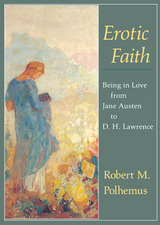 Erotic Faith: Being in Love from Jane Austen to D. H. Lawrence
Robert M. Polhemus
University of Chicago Press, 1990 In this profoundly original and far-reaching study, Robert M. Polhemus shows how novels have helped to make erotic love a matter of faith in modern life. Erotic faith, Polhemus argues, is an emotional conviction—ultimately religious in nature—that meaning, value, hope, and even the possibility of transcendence can be found in love.
Drawing on a wide range of disciplines, Polhemus shows the reciprocity of love as subject, the novel as form, and faith as motive in important works by Jane Austen, Walter Scott, the Brontës, Dickens, George Eliot, Trollope, Thomas Hardy, Joyce, D. H. Lawrence, Virginia Woolf, and Samuel Beckett. Throughout, Polhemus relates the novelists' representation of love to that of such artists as Botticelli, Vermeer, Claude Lorrain, Redon, and Klimt. Juxtaposing their paintings with nineteenth- and twentieth-century texts both reveals the ways in which novels develop and individualize common erotic and religious themes and illustrates how the novel has influenced our perception of all art.
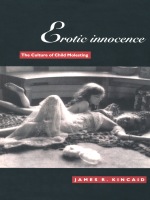 Erotic Innocence: The Culture of Child Molesting
James R. Kincaid
Duke University Press, 1998 In Erotic Innocence James R. Kincaid explores contemporary America’s preoccupation with stories about the sexual abuse of children. Claiming that our culture has yet to come to terms with the bungled legacy of Victorian sexuality, Kincaid examines how children and images of youth are idealized, fetishized, and eroticized in everyday culture. Evoking the cyclic elements of Gothic narrative, he thoughtfully and convincingly concludes that the only way to break this cycle is to acknowledge—and confront—not only the sensuality of children but the eroticism loaded onto them.
Drawing on a number of wide-ranging and well-publicized cases as well as scandals involving such celebrities as Michael Jackson and Woody Allen, Kincaid looks at issues surrounding children’s testimonies, accusations against priests and day-care centers, and the horrifying yet persistently intriguing rumors of satanic cults and “kiddie porn” rings. In analyzing the particular form of popularity shared by such child stars such Shirley Temple and Macaulay Culkin, he exposes the strategies we have devised to deny our own role in the sexualization of children. Finally, Kincaid reminds us how other forms of abuse inflicted on children—neglect, abandonment, inadequate nutrition, poor education—are often overlooked in favor of the sensationalized sexual abuse coverage in the news, on daytime TV talk shows, and in the elevators and cafeterias of America each day.
This bold and critically enlightened book will interest readers across a wide range of disciplines as well as a larger general audience interested in American culture.
Erotic Islands: Art and Activism in the Queer Caribbean
Lyndon K. Gill
Duke University Press, 2018 In Erotic Islands, Lyndon K. Gill maps a long queer presence at a crossroads of the Caribbean. This transdisciplinary book foregrounds the queer histories of Carnival, calypso, and HIV/AIDS in the Republic of Trinidad and Tobago. At its heart is an extension of Audre Lorde's use of the erotic as theory and methodology. Gill turns to lesbian/gay artistry and activism to insist on eros as an intertwined political-sensual-spiritual lens through which to see self and society more clearly. This analysis juxtaposes revered musician Calypso Rose, renowned mas man Peter Minshall, and resilient HIV/AIDS organization Friends For Life. Erotic Islands traverses black studies, queer studies, and anthropology toward an emergent black queer diaspora studies.
 Erotic Knowledge: Toward a Lesbian Feminist Political Theory
Elena Gambino
Duke University Press, 2026 Erotic Knowledge explores how US lesbian feminists raised questions about the political stakes of sexual freedom, how their distinctive political vocabularies informed coalition- and institution-building in ways that strain against contemporary queer and feminist assumptions, and how these alternative grammars were left behind in the decades since lesbian feminism’s remarkable surge in the 1970s. Elena Gambino makes the case that the past of US lesbian feminism is rich in resources not only for rethinking vital questions of sexual freedom in the present, but also for incorporating these questions into a broader understanding of the silencing effects of disciplinary historical knowledge. Drawing on archival sources typically ignored in political theory, such as lesbian feminist poetry, literary criticism, and the publications of small presses and periodicals, Gambino argues that the full extent of lesbian feminists’ contributions should be seen as a distinctive form of political analysis that which can guide lesbian feminist interventions in sexual intimacy, epistemology, and institution-building.
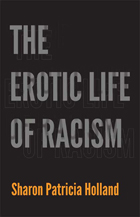 The Erotic Life of Racism
Sharon Patricia Holland
Duke University Press, 2012 A major intervention in the fields of critical race theory, black feminism, and queer theory, The Erotic Life of Racism contends that theoretical and political analyses of race have largely failed to understand and describe the profound ordinariness of racism and the ways that it operates as a quotidian practice. If racism has an everyday life, how does it remain so powerful and yet mask its very presence? To answer this question, Sharon Patricia Holland moves into the territory of the erotic, understanding racism's practice as constitutive to the practice of racial being and erotic choice. Reemphasizing the black/white binary, Holland reinvigorates critical engagement with race and racism. She argues that only by bringing critical race theory, queer theory, and black feminist thought into conversation with each other can we fully envision the relationship between racism and the personal and political dimensions of our desire. The Erotic Life of Racism provocatively redirects our attention to a desire no longer independent of racism but rather embedded within it.
Erotic Morality: The Role of Touch in Moral Agency
Linda Holler
Rutgers University Press, 2002 Erotic Morality examines the role of the senses and the emotions, especially touch, in moral reflection and agency. Moving from organic disorders such as autism to culturally induced feeling disorders found in dualistic philosophy, pornography, and some forms of sadomasochism, Linda Holler argues that reclaiming the sentient awareness necessary to our physical and moral well-being demands healing the places where we have become numb or hypersensitive to touch. By considering ascetic practices designed to produce what Buddhists call mindfulness, Holler presents alternatives to destructive patterns of actions dictated by desensitivity and habitual conditioning.
The Erotic Muse: American Bawdy Songs
Ed Cray
University of Illinois Press, 1992 Ever wanted to know the "correct" words to "Roll Me Over?" Wondered where the melody of "Sweet Betsy from Pike" came from? Ed Cray ranges from "The Cod Fish Song" to "Hallelujah I'm a Bum" in a tireless quest to answer such questions and restore bawdy to an esteemed place in our folk music canon. Extensively revised and including forty more songs than its predecessor, the second edition of The Erotic Muse is a unique collection of bawdy and even forbidden American folksongs. Cray presents the full texts of some 125 works with melodies for most and detailed annotations for all. In addition, he adds lively commentary that places the songs in historical, social, and, where appropriate, psychological context.
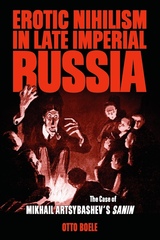 Erotic Nihilism in Late Imperial Russia: The Case of Mikhail Artsybashev's Sanin
Otto Boele
University of Wisconsin Press, 2009 Banned shortly after its publication in 1907, the Russian novel Sanin scandalized readers with the sexual exploits of its eponymous hero. Wreaking havoc on the fictional town he visits in Mikhail Artsybashev’s story, the character Sanin left an even deeper imprint on the psyche of the real-life Russian public. Soon “Saninism” became the buzzword for the perceived faults of the nation. Seen as promoting a wave of hedonistic, decadent behavior, the novel was suppressed for decades, leaving behind only the rumor of its supposedly epidemic effect on a vulnerable generation of youth.
Who were the Saninists, and what was their “teaching” all about? Delving into police reports, newspaper clippings, and amateur plays, Otto Boele finds that Russian youth were not at all swept away by the self-indulgent lifestyle of the novel’s hero. In fact, Saninism was more smoke than fire—a figment of the public imagination triggered by anxieties about the revolution of 1905 and the twilight of the Russian empire. The reception of the novel, Boele shows, reflected much deeper worries caused by economic reforms, an increase in social mobility, and changing attitudes toward sexuality.
Showing how literary criticism interacts with the age-old medium of rumor, Erotic Nihilism in Late Imperial Russia offers a meticulous analysis of the scandal’s coverage in the provincial press and the reactions of young people who appealed to their peers to resist the novel’s nihilistic message. By examining the complex dialogue between readers and writers, children and parents, this study provides fascinating insights into Russian culture on the eve of World War I.
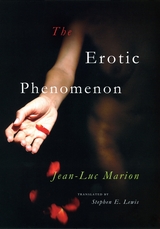 The Erotic Phenomenon
Jean-Luc Marion
University of Chicago Press, 2006 While humanists have pondered the subject of love to the point of obsessiveness, philosophers have steadfastly ignored it. One might wonder whether the discipline of philosophy even recognizes love. The word philosophy means “love of wisdom,” but the absence of love from philosophical discourse is curiously glaring. So where did the love go? In The Erotic Phenomenon, Jean-Luc Marion asks this fundamental question of philosophy, while reviving inquiry into the concept of love itself. Marion begins his profound and personal book with a critique of Descartes’ equation of the ego’s ability to doubt with the certainty that one exists—“I think, therefore I am”—arguing that this is worse than vain. We encounter being, he says, when we first experience love: I am loved, therefore I am; and this love is the reason I care whether I exist or not. This philosophical base allows Marion to probe several manifestations of love and its variations, including carnal excitement, self-hate, lying and perversion, fidelity, the generation of children, and the love of God. Throughout, Marion stresses that all erotic phenomena, including sentimentality, pornography, and even boasts about one’s sexual conquests, stem not from the ego as popularly understood but instead from love. A thoroughly enlightening and captivating philosophical investigation of a strangely neglected subject, The Erotic Phenomenon is certain to initiate feverish new dialogue about the philosophical meanings of that most desirable and mysterious of all concepts—love.
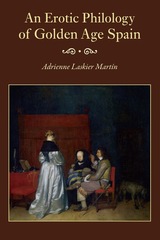 An Erotic Philology of Golden Age Spain
Adrienne Laskier Martin
Vanderbilt University Press, 2007 Early modern Spanish literature is remarkably rich in erotic texts that conventionally chaste critical traditions have willfully disregarded or repudiated as inferior or unworthy of study. Nonetheless, eroticism is a lightning rod for defining mentalities and social, intellectual, and literary history within the nascent field that the author calls erotic philology. An Erotic Philology of Golden Age Spain takes sexuality and eroticism out of the historical closet, placing them at the forefront of early modern humanistic studies. By utilizing theories of deviance, sexuality, and gender; the rhetoric of eroticism; and textual criticism, An Erotic Philology of Golden Age Spain historicizes and analyzes the particular ways in which classical Spanish writers assign symbolic meaning to non-normative sexual practices and their practitioners. It shows how prostitutes, homosexuals, transvestites, women warriors, and female tricksters were stigmatized and marginalized as part of an ordering principle in the law, society, and in literature. It is against these sexual outlaws that early modern orthodoxy establishes and identifies itself during the Golden Age of Spanish letters. These eroticized figures are recurring objects of contemplation and fascination for Spain's most canonical as well as lesser known writers of the period, in a variety of poetic, prose and dramatic genres. They ultimately reveal attitudes towards sexual behavior that are far more complex than was previously thought. An Erotic Philology of Golden Age Spain thoughtfully anatomizes the interdisciplinary systems at the heart of the varied sexual behaviors depicted in early modern Spanish literature.
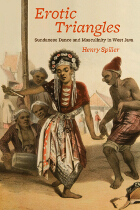 Erotic Triangles: Sundanese Dance and Masculinity in West Java
Henry Spiller
University of Chicago Press, 2010 In West Java, Indonesia, all it takes is a woman’s voice and a drum beat to make a man get up and dance. Every day, men there—be they students, pedicab drivers, civil servants, or businessmen—breach ordinary standards of decorum and succumb to the rhythm at village ceremonies, weddings, political rallies, and nightclubs. The music the men dance to varies from traditional gong ensembles to the contemporary pop known as dangdut, but they consistently dance with great enthusiasm. In Erotic Triangles, Henry Spiller draws on decades of ethnographic research to explore the reasons behind this phenomenon, arguing that Sundanese men use dance to explore and enact contradictions in their gender identities.
Framing the three crucial elements of Sundanese dance—the female entertainer, the drumming, and men’s sense of freedom—as a triangle, Spiller connects them to a range of other theoretical perspectives, drawing on thinkers from Eve Kosofsky Sedgwick, Lévi-Strauss, and Freud to Euclid. By granting men permission to literally perform their masculinity, Spiller ultimately concludes, dance provides a crucial space for both reinforcing and resisting orthodox gender ideologies.
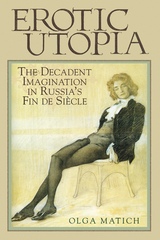 Erotic Utopia: The Decadent Imagination in Russia's Fin de Siecle
Olga Matich
University of Wisconsin Press, 2007 The first generation of Russian modernists experienced a profound sense of anxiety resulting from the belief that they were living in an age of decline. What made them unique was their utopian prescription for overcoming the inevitability of decline and death both by metaphysical and physical means. They intertwined their mystical erotic discourse with European degeneration theory and its obsession with the destabilization of gender. In Erotic Utopia, Olga Matich suggests that same-sex desire underlay their most radical utopian proposal of abolishing the traditional procreative family in favor of erotically induced abstinence. 2006 Winner, CHOICE Award for Outstanding Academic Titles, Current Reviews for Academic Libraries Honorable Mention, Aldo and Jean Scaglione Prize for Studies in Slavic Languages and Literatures, Modern Language Association
“Offers a fresh perspective and a wealth of new information on early Russian modernism. . . . It is required reading for anyone interested in fin-de-siècle Russia and in the history of sexuality in general.”—Bernice Glatzer Rosenthal, Slavic and East European Journal
“Thoroughly entertaining.”—Avril Pyman, Slavic Review
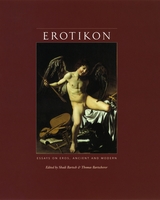 Erotikon: Essays on Eros, Ancient and Modern
Edited by Shadi Bartsch and Thomas Bartscherer
University of Chicago Press, 2005 Erotikon brings together leading contemporary intellectuals from a variety of fields for an expansive debate on the full meaning of eros. Renowned scholars of philosophy, literature, classics, psychoanalysis, theology, and art history join poets and a novelist to offer fresh insights into a topic that is at once ancient and forever young. Restricted neither by historical period nor by genre, these contributions explore manifestations of eros throughout Western culture, in subjects ranging from ancient philosophy and baroque architecture to modern literature and Hollywood cinema.
An idea charged with paradox, eros has always defied categorization, and yet it cannot—it will not—be ignored. Erotikon aims to raise the difficult question of what, if anything, unifies the erotic manifold. How is eros in a sculpture like eros in a poem? Does the ancient story of Cupid and Psyche still speak meaningfully to modern readers, and if so, why? Is Plato's eros the same as Freud's? Or Proust's? And what is the erotic dimension in Nietzsche's thought? While each essay takes on a specific issue, together they constitute a wide-ranging conversation in which these broader questions are at play. A compilation of the latest, best efforts to reckon with eros, Erotikon will appeal not just to scholars and educators, but also to artists and critics, to the curious and the disillusioned, to the prurient and the prudent.
Erou
Maya Phillips
Four Way Books, 2019 Maya Phillips’ stunning debut collection Erou borrows the framework of the traditional Greek epic to interrogate the inner workings of a present-day nuclear family and the role of a patriarch whose life, marriage, and death are imagined as a sort of hero’s journey. Her poems move seamlessly between the worlds of the living and the dead, between myth and reality in a journey that raises its own Homeric question: What is home and how do we locate our place within that home? These are poems of passion and compassion in their reconciliation with what cannot be changed—but can be understood—by those who have been left behind.
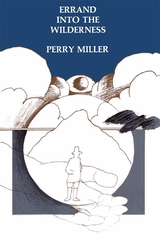 Errand into the Wilderness
Perry Miller
Harvard University Press, 1984 The title of this book by Perry Miller, who is world-famous as an interpreter of the American past, comes close to posing the question it has been Mr. Miller's lifelong purpose to answer: What was the underlying aim of the first colonists in coming to America? In what light did they see themselves? As men and women undertaking a mission that was its own cause and justification? Or did they consider themselves errand boys for a higher power which might, as is frequently the habit of authority, change its mind about the importance of their job before they had completed it?
These questions are by no means frivolous. They go to the roots of seventeenth-century thought and of the ever-widening and quickening flow of events since then. Disguised from twentieth-century readers first by the New Testament language and thought of the Puritans and later by the complacent transcendentalist belief in the oversoul, the related problems of purpose and reason-for-being have been central to the American experience from the very beginning. Mr. Miller makes this abundantly clear and real, and in doing so allows the reader to conclude that, whatever else America might have become, it could never have developed into a society that took itself for granted.
The title, Errand into the Wilderness, is taken from the title of a Massachusetts election sermon of 1670. Like so many jeremiads of its time, this sermon appeared to be addressed to the sinful and unregenerate whom God was about to destroy. But the original speaker's underlying concern was with the fateful ambiguity in the word errand. Whose errand?
This crucial uncertainty of the age is the starting point of Mr. Miller's engrossing account of what happened to the European mind when, in spite of itself, it began to become something other than European. For the second generation in America discovered that their heroic parents had, in fact, been sent on a fool's errand, the bitterest kind of all; that the dream of a model society to be built in purity by the elect in the new continent was now a dream that meant nothing more to Europe. The emigrants were on their own. Thus left alone with America, who were they? And what were they to do?
In this book, as in all his work, the author of The New England Mind: The Seventeenth Century; The New England Mind: From Colony to Province, and The Transcendentalists, emphasizes the need for understanding the human sources from which the American mainstream has risen. In this integrated series of brilliant and witty essays which he describes as "pieces," Perry Miller invites and stimulates in the reader a new conception of his own inheritance.
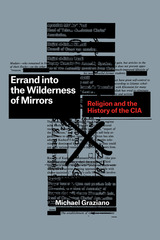 Errand into the Wilderness of Mirrors: Religion and the History of the CIA
Michael Graziano
University of Chicago Press, 2021 Reveals the previous underexplored influence of religious thought in building the foundations of the CIA.
Michael Graziano’s intriguing book fuses two landmark titles in American history: Perry Miller’s Errand into the Wilderness (1956), about the religious worldview of the early Massachusetts colonists, and David Martin’s Wilderness of Mirrors (1980), about the dangers and delusions inherent to the Central Intelligence Agency. Fittingly, Errand into the Wilderness of Mirrors investigates the dangers and delusions that ensued from the religious worldview of the early molders of the Central Intelligence Agency. Graziano argues that the religious approach to intelligence by key OSS and CIA figures like “Wild” Bill Donovan and Edward Lansdale was an essential, and overlooked, factor in establishing the agency’s concerns, methods, and understandings of the world. In a practical sense, this was because the Roman Catholic Church already had global networks of people and safe places that American agents could use to their advantage. But more tellingly, Graziano shows, American intelligence officers were overly inclined to view powerful religions and religious figures through the frameworks of Catholicism. As Graziano makes clear, these misconceptions often led to tragedy and disaster on an international scale. By braiding the development of the modern intelligence agency with the story of postwar American religion, Errand into the Wilderness of Mirrors delivers a provocative new look at a secret driver of one of the major engines of American power.
Errand to the World: American Protestant Thought and Foreign Missions
William R. Hutchison
University of Chicago Press, 1987 In this comprehensive history of American foreign-mission thought from the colonial period to the current era, William R. Hutchinson analyzes the varied and changing expressions of an American "sense of mission" that was more than religious in its implications. His account illuminates the dilemmas intrinsic to any venture in which one culture attempts to apply its ideals and technology to the supposed benefit of another.
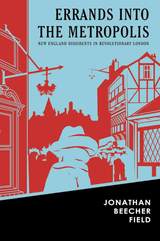 Errands into the Metropolis: New England Dissidents in Revolutionary London
Jonathan Beecher Field
Dartmouth College Press, 2012 Errands into the Metropolis offers a dramatic new interpretation of the texts and contexts of early New England literature. Jonathan Beecher Field inverts the familiar paradigm of colonization as an errand into the wilderness to demonstrate, instead, that New England was shaped and re-shaped by a series of return trips to a metropolitan London convulsed with political turmoil. In London, dissidents and their more orthodox antagonists contended for colonial power through competing narratives of their experiences in the New World. Dissidents showed a greater willingness to construct their narratives in terms that were legible to a metropolitan reader than did Massachusetts Bay’s apologists. As a result, representatives of a variety of marginal religious groups were able to secure a remarkable level of political autonomy, visible in the survival of Rhode Island as an independent colony. Through chapters focusing on John Cotton, Roger Williams, Samuel Gorton, John Clarke, and the Quaker martyrs, Field traces an evolving discourse on the past, present, and future of colonial New England that revises the canon of colonial New England literature and the contours of New England history. In the broader field of early American studies, Field’s work demonstrates the benefits of an Atlantic perspective on the material cultures of print. In the context of religious freedom, Errands into the Metropolis shows Rhode Island’s famous culture of toleration emerging as a pragmatic response to the conditions of colonial life, rather than as an idealistic principle. Errands into the Metropolis offers new understanding of familiar texts and events from colonial New England, and reveals the significance of less familiar texts and events.
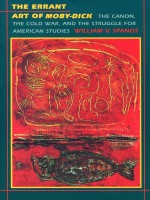 The Errant Art of Moby-Dick: The Canon, the Cold War, and the Struggle for American Studies
William V. Spanos
Duke University Press, 1995 In The Errant Art of Moby-Dick, one of America’s most distinguished critics reexamines Melville’s monumental novel and turns the occasion into a meditation on the history and implications of canon formation. In Moby-Dick—a work virtually ignored and discredited at the time of its publication—William V. Spanos uncovers a text remarkably suited as a foundation for a "New Americanist" critique of the ideology based on Puritan origins that was codified in the canon established by "Old Americanist" critics from F. O. Matthiessen to Lionel Trilling. But Spanos also shows, with the novel still as his focus, the limitations of this "New Americanist" discourse and its failure to escape the totalizing imperial perspective it finds in its predecessor.
Combining Heideggerian ontology with a sociopolitical perspective derived primarily from Foucault, the reading of Moby-Dick that forms the center of this book demonstrates that the traditional identification of Melville’s novel as a "romance" renders it complicitous in the discourse of the Cold War. At the same time, Spanos shows how New Americanist criticism overlooks the degree to which Moby-Dick anticipates not only America’s self-representation as the savior of the world against communism, but also the emergent postmodern and anti-imperial discourse deployed against such an image. Spanos’s critique reveals the extraordinary relevance of Melville’s novel as a post-Cold War text, foreshadowing not only the self-destructive end of the historical formation of the American cultural identity in the genocidal assault on Vietnam, but also the reactionary labeling of the current era as "the end of history."
This provocative and challenging study presents not only a new view of the development of literary history in the United States, but a devastating critique of the genealogy of ideology in the American cultural establishment.
 An Errant Eye: Poetry and Topography in Early Modern France
Tom Conley
University of Minnesota Press, 2010 An Errant Eye studies how topography, the art of describing local space and place, developed literary and visual form in early modern France. Arguing for a "new poetics of space" ranging throughout French Renaissance poetry, prose, and cartography, Tom Conley performs dazzling readings of maps, woodcuts, and poems to plot a topographical shift in the late Renaissance in which space, subjectivity, and politics fall into crisis. He charts the paradox of a period whose demarcation of national space through cartography is rendered unstable by an ambient world of printed writing.
This tension, Conley demonstrates, cuts through literature and graphic matter of various shapes and forms-hybrid genres that include the comic novel, the emblem-book, the eclogue, sonnets, and the personal essay. An Errant Eye differs from historical treatments of spatial invention through Conley's argument that the topographic sensibility is one in which the ocular faculty, vital to the description of locale, is endowed with tact and touch.
Detailed close readings of Apian, Rabelais, Montaigne, and others empower the reader with a lively sense of the topographical impulse, deriving from Conley's own "errant eye," which is singularly discerning in attentiveness to the ambiguities of charted territory, the contours of woodcut images, and the complex combinations of word and figure in French Renaissance poetry, emblem, and politics.
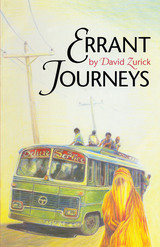 Errant Journeys: Adventure Travel in a Modern Age
By David Zurick
University of Texas Press, 1995 Tourism is becoming one of the world's most important economic activities. There is hardly a place on earth, no matter how inaccessible, that has not been visited by some traveler seeking adventure, enlightenment, or simply change from the familiar world back home. In this pathfinding book, David Zurick explores the fastest-growing segment of the travel industry—adventure travel. He raises important questions about what constitutes the travel experience and shows how the modern adventure industry has commercialized the very notion of adventure by packaging it as tours. Drawing on two decades of personal travel, as well as the writings of others, Zurick unravels the paradox of adventure travel—that the very act of visiting remote places untouched by Western culture introduces that culture and begins irreversible changes. This first in-depth look at adventure travel opens new insights into the physical, philosophical, and spiritual attributes of the travel experience. Written in a lively style, the book is intended for everyone interested in travel and its effects on both travelers and the people and places they visit.
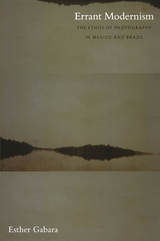 Errant Modernism: The Ethos of Photography in Mexico and Brazil
Esther Gabara
Duke University Press, 2008 Making a vital contribution to the understanding of Latin American modernism, Esther Gabara rethinks the role of photography in the Brazilian and Mexican avant-garde movements of the 1920s and 1930s. During these decades, intellectuals in Mexico and Brazil were deeply engaged with photography. Authors who are now canonical figures in the two countries’ literary traditions looked at modern life through the camera in a variety of ways. Mário de Andrade, known as the “pope” of Brazilian modernism, took and collected hundreds of photographs. Salvador Novo, a major Mexican writer, meditated on the medium’s aesthetic potential as “the prodigal daughter of the fine arts.” Intellectuals acted as tourists and ethnographers, and their images and texts circulated in popular mass media, sharing the page with photographs of the New Woman. In this richly illustrated study, Gabara introduces the concept of a modernist “ethos” to illuminate the intertwining of aesthetic innovation and ethical concerns in the work of leading Brazilian and Mexican literary figures, who were also photographers, art critics, and contributors to illustrated magazines during the 1920s and 1930s. Gabara argues that Brazilian and Mexican modernists deliberately made photography err: they made this privileged medium of modern representation simultaneously wander and work against its apparent perfection. They flouted the conventions of mainstream modernism so that their aesthetics registered an ethical dimension. Their photographic modernism strayed, dragging along the baggage of modernity lived in a postcolonial site. Through their “errant modernism,” avant-garde writers and photographers critiqued the colonial history of Latin America and its twentieth-century formations.
Errata
Lisa Fay Coutley
Southern Illinois University Press, 2016 COR series Open Competition winner
Finalist, INDIEFAB Book of the Year
Lisa Fay Coutley’s lyrical debut collection, Errata, investigates the delicate balance between parent and child, love and loss, hope and grief. Errata’s narrator reflects on struggles and fears that span generations in compositions that are at once musical and bleak. Coutley’s narrative journey is often a dark one, exploring not only the loss of loved ones but also the potential to lose one’s very self. The collection unravels the lingering consequences of abuse and addiction, yet threads of hope and determination weave a finely wrought path through the dark side of human relationships, illuminating the power of the will to survive. Coutley’s sharp yet tender collection will both haunt readers and move them to reflect, to remember, and most of all, to persevere.
Erring: A Postmodern A/theology
Mark C. Taylor
University of Chicago Press, 1984 "Erring is a thoughtful, often brilliant attempt to describe and enact what remains of (and for) theology in the wake of deconstruction. Drawing on Hegel, Nietzsche, Derrida, and others, Mark Taylor extends—and goes well beyond—pioneering efforts. . . . The result is a major book, comprehensive and well-informed."—G. Douglas Atkins, Philosophy and Literature
"Many have felt the need for a study which would explicate in coherent and accessible fashion the principal tenets of deconstruction, with particular attention to their theological implications. This need the author has addressed in a most impressive manner. The book's effect upon contemporary discussion is apt to be, and deserves to be, far-reaching."—Walter Lowe, Journal of Religion
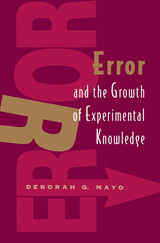 Error and the Growth of Experimental Knowledge
Deborah G. Mayo
University of Chicago Press, 1996 We may learn from our mistakes, but Deborah Mayo argues that, where experimental knowledge is concerned, we haven't begun to learn enough. Error and the Growth of Experimental Knowledge launches a vigorous critique of the subjective Bayesian view of statistical inference, and proposes Mayo's own error-statistical approach as a more robust framework for the epistemology of experiment. Mayo genuinely addresses the needs of researchers who work with statistical analysis, and simultaneously engages the basic philosophical problems of objectivity and rationality.
Mayo has long argued for an account of learning from error that goes far beyond detecting logical inconsistencies. In this book, she presents her complete program for how we learn about the world by being "shrewd inquisitors of error, white gloves off." Her tough, practical approach will be important to philosophers, historians, and sociologists of science, and will be welcomed by researchers in the physical, biological, and social sciences whose work depends upon statistical analysis.
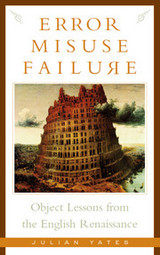 Error, Misuse, Failure: Object Lessons From The English Renaissance
Julian Yates
University of Minnesota Press, 2002 Explores what an object tells us about the culture that created it.
If certain objects work well, no one notices them. As with "black boxes," their success may be gauged by their relative invisibility-and this was the indirect goal of the objects that Julian Yates considers here: the portrait miniature, the relic, the privy (flush toilet), the printed text, and the priest-hole (a secret hiding place for Catholic priests in Protestant England).
Because each of these contrivances was prone to error, misuse, and sometimes catastrophic failure, they become in Yates's analysis an occasion for recasting the history of the English Renaissance as object lessons-"knowing from the point of view of the known." It is through such lapses-the texts and stories generated to explain away a relic that is too easily faked, a miniature that is too curiously real, the stench of a failing privy, a book that persistently sheds its pages, or the presence of so much "papist trash" in an ostensibly reformed England-that Yates recovers the silent work of "things" in cultural production.
Drawing object lessons from failing technological devices, Error, Misuse, Failure plumbs the foundations of Renaissance culture in England, recovering a curious language of mistakes, dirt, and parasitism that associates the failures of these "things" with the figures of Rome, Catholicism, and Sodom. Yates offers a mode of historical inquiry rooted in material culture, sensitive to the way humans induct nonhumans (animals, plants, and manufactured things) into their communities. Historically, the book offers a new set of stories about the rise of printing, the development of domestic architecture, and England's Catholic community-stories that remind readers of the ways in which attending to the history of nonhumans requires a radical rethinking of historical landmarks and boundaries.
Julian Yates is associate professor of English at the University of Delaware.
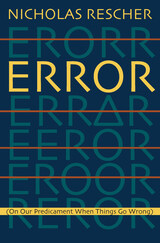 Error: (On Our Predicament When Things Go Wrong )
Nicholas Rescher
University of Pittsburgh Press, 2009
In Error, Nicholas Rescher presents a fresh analysis of the occurrence, causality, and consequences of error in human thought, action, and evaluation. Rescher maintains that error-avoidance and truth-achievement are distinct but equally important factors for rational inquiry, and that error is inherent in the human cognitive process (to err is human). He defines three main categories of error: cognitive (failure to realize truths); practical (failure related to the objective of an action); and axiological (failure in evaluation), and articulates the factors that contribute to each. His discussion also provides a historical perspective on the treatment of error in Greek philosophy, and by later thinkers such as Aquinas, Descartes, Spinoza, Leibniz, James, Royce, Moore, and Russell.
Error is an important reexamination of the significance of error to the fields of philosophical anthropology, epistemology, ontology, and theology. As Rescher’s study argues, truth and error are inexorably intertwined—one cannot exist without the other. Error is an unavoidable occurrence in the cognitive process—without missteps on the path to truth, truth itself cannot be attained. The risk of error is inherent in the quest for truth.
Errors, Lies, and Libel
Peter E. Kane. Foreword by Elmer Gertz
Southern Illinois University Press, 1992 Peter E. Kane takes a critical look at the development of the present law through a discussion of seventeen landmark libel cases. One of the many points Kane clarifies is the important distinction between an error and a lie when judging whether someone is guilty of libel. For example, in the series of events that led to Goldwater vs. Ginzburg, Ralph Ginzburg, publisher of fact magazine, compiled and printed in fact a montage of quotes he had collected from psychiatrists about Barry Goldwater. It took five years of legal sparring for the courts to conclude that Ginzburg had deliberately published a malicious and irresponsible document and to rule in favor of Goldwater. Kane closes with a discussion of current thinking on possible libel reform.
 Erskine Caldwell - American Writers 78: University of Minnesota Pamphlets on American Writers
James Korges
University of Minnesota Press, 1969 Erskine Caldwell - American Writers 78 was first published in 1969. Minnesota Archive Editions uses digital technology to make long-unavailable books once again accessible, and are published unaltered from the original University of Minnesota Press editions. This pamphlet series has been hailed by critics, teachers, and librarians as an ideals means of introducing both students and general readers to American writers of all periods. Choice has commented: "For the small library this series offers at small cost introductions by reputable critics o dozens of significant authors, and the larger the library the greater the number of undergraduate students looking for a place to start on some writer." The New York Times Book Review has called the pamphlets "extraordinarily good," pointing out that "they are just long enough (48 pages) to permit a real survey of an author's work and short enough to attract the casual reader, the anxiety-ridden student, and the professor desperate for the straight word on an unfamiliar writer."
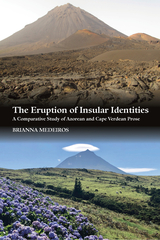 The Eruption of Insular Identities: A Comparative Study of Azorean and Cape Verdean Prose
Brianna Medeiros
Sussex Academic Press, 2022 The Eruption of Insular Identities; explores themes common to the literatures of the Azores and Cape Verde, two isolated archipelagos in the former Portuguese empire but contemporaneously in the Portuguese-speaking world. In the 1930s, writers from both archipelagos initiated projects to explore aorianidade and caboverdianidade, firmly placing narratives within their respective regional spaces, a tradition that would be continued by following generations. Despite vast differences in the realities in the two archipelagos in terms of race and politics, the insularity lent itself to two bodies of literature with striking similarities. The author's aim is to set out these similarities as a means to understanding the differences in rhetoric and treatment of this commonality. This book is the first extensive study comparing the literatures of the two archipelagos. Cape Verdean writer Germano Almeida won the Prmio Cames in 2018, one of the most prestigious awards for Portuguese-language authors; his work is explored extensively in the volume. The Eruption of Insular Identities; provides a perspective on Cape Verdean literature that brings to the fore the nation's social reality and literary production—its individual insularity—which distances it from most of the other Lusophone African nations, and provides an in-depth comparison to the second region under study, the Azores.
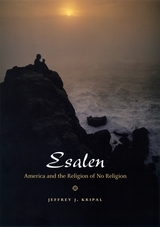 Esalen: America and the Religion of No Religion
Jeffrey J. Kripal
University of Chicago Press, 2007 Jeffrey Kripal here recounts the spectacular history of Esalen, the institute that has long been a world leader in alternative and experiential education and stands today at the center of the human potential movement. Forged in the literary and mythical leanings of the Beat Generation, inspired in the lecture halls of Stanford by radical scholars of comparative religion, the institute was the remarkable brainchild of Michael Murphy and Richard Price. Set against the heady backdrop of California during the revolutionary 1960s, Esalen recounts in fascinating detail how these two maverick thinkers sought to fuse the spiritual revelations of the East with the scientific revolutions of the West, or to combine the very best elements of Zen Buddhism, Western psychology, and Indian yoga into a decidedly utopian vision that rejected the dogmas of conventional religion. In their religion of no religion, the natural world was just as crucial as the spiritual one, science and faith not only commingled but became staunch allies, and the enlightenment of the body could lead to the full realization of our development as human beings.
“An impressive new book. . . . [Kripal] has written the definitive intellectual history of the ideas behind the institute.”—San Francisco Chronicle
“Kripal examines Esalen’s extraordinary history and evocatively describes the breech birth of Murphy and Price’s brainchild. His real achievement, though, is effortlessly synthesizing a dizzying array of dissonant phenomena (Cold War espionage, ecstatic religiosity), incongruous pairings (Darwinism, Tantric sex), and otherwise schizy ephemera (psychedelic drugs, spaceflight) into a cogent, satisfyingly complete narrative.”—Atlantic Monthly “Kripal has produced the first all-encompassing history of Esalen: its intellectual, social, personal, literary and spiritual passages. Kripal brings us up-to-date and takes us deep beneath historical surfaces in this definitive, elegantly written book.”—Playboy
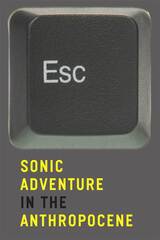 ESC: Sonic Adventure in the Anthropocene
Jacob Smith
University of Michigan Press, 2019 ESC is a work of experimental audio-based scholarship combining sound studies, radio history, and environmental criticism. This unique project is a fully open access, fully digital suite of audiographic essays, presented as a ten-part podcast series, combining spoken commentary, clips from classic radio dramas, excerpts from films and television shows, news reports, and the work of contemporary sound artists. A brief written essay on the ESC website provides a helpful introduction and context for this project. ESC takes as its point of departure the CBS Radio adventure series Escape (1947–54). The postwar years saw both a decline in popularity for American radio drama, and the dawn of the Anthropocene era, with human beings emerging as the primary force affecting the earth’s systems. Jacob Smith considers Escape’s adventure stories from an ecocritical perspective, analyzing the geographic, sociopolitical, and ecological details of the stories to reveal how they are steeped in social and environmental history. The work of contemporary sound artists and field recordists underscores the relevance of sound in these narratives and demonstrates audio’s potential as a key medium for scholarship. ESC features recordings by some of the most prominent sound artists working in this area, including Daniel Blinkhorn, Peter Cusak, David Dunn, JLIAT, Christina Kubisch, Francisco López, Sally Ann McIntyre, Chris Watson, and Jana Winderen. ESC makes the urgency of our critical ecological moment audible in a new way. The audio essays articulate what it means to live in an Anthropocene era and posit alternative ways of conceptualizing our historical moment. ESC sharpens our ability to listen and respond to our world with greater ecological awareness. All publication resources for ESC, including the introductory essay, audio materials, and backmatter, are available on Fulcrum. The audio materials are also available on Apple Podcasts.
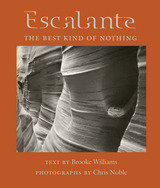 Escalante: The Best Kind of Nothing
Text by Brooke Williams; Photographs by Chris Noble
University of Arizona Press, 2006 “There is nothing out there.” Such is the claim, at least, of politicians and oil company executives, amazed that anyone would fight to protect the miles of plateaus and canyon bottoms that stretch across southern Utah. Even tourists see this region as an empty spot on the map—an excuse to drive directly from Capitol Reef to Arches National Park. But it is precisely this—nothing—that writer Brooke Williams and photographer Chris Noble find captivating about Escalante. In this thoughtful and exquisitely illustrated rumination, the authors tour the network of chasms and gorges that began forming millions of years ago on the Colorado Plateau and today constitute a desert paradise of mesas, buttes, and boundless solitude. At the center of this landscape is the region known as Escalante, 1.7 million mostly roadless acres, where silence, darkness, and emptiness have no intrusions. With refreshing originality and a haunting rhythm to his prose, Williams reflects on the notion of space and seclusion both internally and externally. Williams also celebrates the landscape: its geology, flora and fauna, its people from the ancient Fremont to its Mormon pioneers, hiking aficionados and recluses such as Everett Ruess, and the controversial politics involved with the creation of Grand Staircase-Escalante National Monument. Chris Noble’s photographs break down the distinction often felt even in very fine photos, that between the observer and the place. These images pull the reader into the landscape, seamlessly merging the experience and the setting. Part narrative, part poetry, and part meditation, this book charts the quiet places where the human spirit delights in solitude. It reminds us of our intimate connection with the wild and of the landscape’s powerful pulse especially when there is nothing to be found.
Escalation in the War in Ukraine: Lessons Learned and Risks for the Future
Bryan Frederick
RAND Corporation, 2023 This report evaluates the potential for further escalation in the conflict in Ukraine, including the prospects for escalation to Russian nuclear use. The report is intended to inform U.S. and NATO policymakers as they consider how to avoid further escalation of the conflict while assisting Ukraine in its efforts to defeat the Russian invasion and to better inform the public debate around these issues.
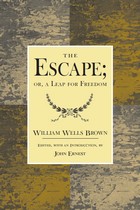 The Escape: A Leap For Freedom
William Wells Brown
University of Tennessee Press, 2001 A well-known nineteenth-century abolitionist and former slave, William Wells Brown was a prolific writer and lecturer who captivated audiences with readings of his drama The Escape; or, a Leap for Freedom (1858). The first published play by an African American writer, The Escape explored the complexities of American culture at a time when tensions between North and South were about to explode into the Civil War. This new volume presents the first-edition text of Brown’s play and features an extensive introduction that establishes the work’s continuing significance.
The Escape centers on the attempted sexual violation of a slave and involves many characters of mixed race, through which Brown commented on such themes as moral decay, white racism, and black self-determination. Rich in action and faithful in dialect, it raises issues relating not only to race but also to gender by including concepts of black and white masculinity and the culture of southern white and enslaved women. It portrays a world in which slavery provided a convenient means of distinguishing between the white North and the white South, allowing northerners to express moral sentiments without recognizing or addressing the racial prejudice pervasive among whites in both regions.
John Ernest’s introductory essay balances the play's historical and literary contexts, including information on Brown and his career, as well as on slavery, abolitionism, and sectional politics. It also discusses the legends and realities of the Underground Railroad, examines the role of antebellum performance art—including blackface minstrelsy and stage versions of Uncle Tom's Cabin—in the construction of race and national identity, and provides an introduction to theories of identity as performance.
A century and a half after its initial appearance, The Escape remains essential reading for students of African American literature. Ernest's keen analysis of this classic play will enrich readers’ appreciation of both the drama itself and the era in which it appeared.
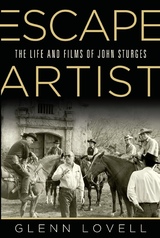 Escape Artist: The Life and Films of John Sturges
Glenn Lovell
University of Wisconsin Press, 2008 Escape Artist—based on Glenn Lovell’s extensive interviews with John Sturges, his wife and children, and numerous stars including Clint Eastwood, Robert Duvall, and Jane Russell—is the first biography of the director of such acclaimed films as The Magnificent Seven, The Great Escape, and Bad Day at Black Rock. Lovell examines Sturges’s childhood in California during the Great Depression; his apprenticeship in the editing department of RKO Pictures, where he worked on such films as Gunga Din and Of Human Bondage; his service in the Army Air Corps in World War II; and his emergence as one of the first independent producer-directors in Hollywood. Chronicling the filmmaker’s relationships with such luminaries as Spencer Tracy, James Garner, Yul Brynner, and Frank Sinatra, Escape Artist interweaves biography with critical analyses of Sturges’s hits and misses. Along the way, Lovell addresses the reasons why Sturges has been overlooked in the ongoing discussion of postwar Hollywood and explores the director’s focus on masculinity, machismo, and male-bonding in big-budget, ensemble action films. Lovell also examines Sturges’s aesthetic sensibility, his talent for composing widescreen images, and his uncanny ability to judge raw talent—including that of Steve McQueen, Charles Bronson, and James Coburn, all of whom began their careers in Sturges’s movies. This long overdue study of a major Hollywood director will find a welcome home in the libraries of film scholars, action movie buffs, and anyone interested in the popular culture of the twentieth century.
Best Books for Special Interests, selected by the American Association of School Librarians, and Best Books for General Audiences, selected by the Public Library Association
"Pick up a copy of film critic and scholar Glenn Lovell's terrific new Sturges biography, Escape Artist. . . . I can't urge you enough to check out this interview-rich, aesthetically and culturally perceptive look at the filmmaker and his work."—Bob Strauss, Los Angeles Daily News
“Lovell’s list of interviewees reads like a who’s who of Hollywood and they obviously provided rich source material for this full-scale biography and career survey.”— Leonard Maltin
“This long overdue study of a major Hollywood director will find a welcome home in the libraries of film scholars, action movie buffs, and anyone interested in the popular culture of the twentieth century.”—Turner Classic Movies (TCM.com)
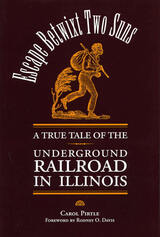 Escape Betwixt Two Suns: A True Tale of the Underground Railroad in Illinois
Carol Pirtle. Foreword by Rodney O. Davis
Southern Illinois University Press, 2000 Although the northern Illinois chapters of the story of Susan “Sukey” Richardson’s escape from slavery on the Underground Railroad are documented, the part played by southern Illinois in that historic episode has remained obscure. Carol Pirtle changes that with her investigation into the 1843 suit Andrew Borders lodged against William Hayes, charging his neighbor with helping slaves from the Borders estate escape to Galesburg. In conjunction with her probe into the past, Pirtle also discovered the Hayes correspondence. Pirtle documents Hayes’s involvement in the Illinois Underground Railroad through approximately two hundred letters received by Hayes from the early 1820s until his death in 1849. Many of these letters specifically corroborate his participation in the escape of slaves from the Borders estate. One such letter came from T. A. Jones in 1843: “You Dear Sir are to me an unknown friend, yet I believe you are a friend to the poor down trodden Slave. This is as good an introduction as I want from any man. My brother, our cause is a holy one.” Letters written by Galesburg residents show that several prominent citizens of that community also assisted in the affair, proving that Knox College administrators and trustees were active in the Underground Railroad. Pirtle also includes excerpts from the trial transcript from the 1844 civil case against Hayes, which was tried in Pinckneyville, Illinois. She researched newspaper accounts of the event, most notably those in the Western Citizen and the Sparta Herald. Records of the Covenanter Presbyterian church of which Hayes was a member provide partial explanations of Hayes’s motives. Telling the story of Hayes and his involvement with Susan Richardson and the Underground Railroad, Pirtle provides insight into the work of abolitionists in Illinois. Escape Betwixt Two Suns, in fact, is one of the few books to substantiate the legends of the Underground Railroad. She tells the story of a quiet man who made a difference, of a man deserving the accolades of a hero.
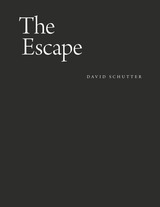 The Escape: From a Seventeenth-Century Drawing Manual of the Face and Its Expressions
David Schutter
University of Chicago Press, 2021 Charles Le Brun’s drawing manual on human emotions has been used for centuries by artists and students as a model for depicting facial expressions. In David Schutter’s work, Le Brun’s manual is set to a different direction—a series of abstract drawings recalling vestiges of the human face animated by emotion. But Schutter’s drawings are neither copies nor portraiture. Rather, they are reflections on how Lebrun’s renderings were made.
Collected here, Schutter’s work recreates not the subject matter but the very values of Lebrun’s drawings—light, gesture, scale, and handling of materials. The cross-hatching in the original was used to make classical tone and volume, in Schutter’s hand the technique makes for unstable impressions of strained neck and deeply furrowed brow, or for drawing marks and scribbles unto themselves. As such, these drawings end up denying a neat closure—unlike their academic source material—and render unsettling states of mind that require repeated viewing. Accompanied by essays from art critic Barry Schwabsky and Neubauer Collegium curator Dieter Roelstraete, The Escape will appeal to students, critics, and admirers of seventeenth-century, modern, and contemporary art alike.
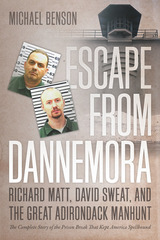 Escape from Dannemora: Richard Matt, David Sweat, and the Great Adirondack Manhunt
Michael Benson
University Press of New England, 2017 It was one of the biggest crime stories of the decade—two deadly killers, desperate and on the run. After months of planning, Ricky Matt and David Sweat cut, chopped, coerced, and connived their way out of a maximum-security prison in the wilderness of upstate New York and managed to elude police for three weeks, sending the region into lockdown and keeping the entire country on edge. The media called it “a bold escape for the ages,” and veteran true-crime writer Michael Benson leads us along the story’s every wild path to dig out a tale of adventure, psychology, sex, and brutality. Escape from Dannemora examines the strange case of Joyce Mitchell, the long-time prison employee who had a sexual relationship with at least one of the killers, and who smuggled them tools and aided in the escape, while they cooked up a plan to kill her husband. In the end, Benson looks closely at conditions at the Clinton Correctional Facility in Dannemora, NY, a crumbling Gothic pile now under investigation for charges of drug trafficking and brutality.
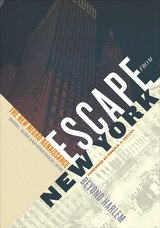 Escape from New York: The New Negro Renaissance beyond Harlem
Davarian L. Baldwin
University of Minnesota Press, 2013 In the midst of vast cultural and political shifts in the early twentieth century, politicians and cultural observers variously hailed and decried the rise of the “New Negro.” This phenomenon was most clearly manifest in the United States through the outpouring of Black arts and letters and social commentary known as the Harlem Renaissance. What is less known is how far afield of Harlem that renaissance flourished—how much the New Negro movement was actually just one part of a collective explosion of political protest, cultural expression, and intellectual debate all over the world. In this volume, the Harlem Renaissance “escapes from New York” into its proper global context. These essays recover the broader New Negro experience as social movements, popular cultures, and public behavior spanned the globe from New York to New Orleans, from Paris to the Philippines and beyond. Escape from New York does not so much map the many sites of this early twentieth-century Black internationalism as it draws attention to how New Negroes and their global allies already lived. Resituating the Harlem Renaissance, the book stresses the need for scholarship to catch up with the historical reality of the New Negro experience. This more comprehensive vision serves as a lens through which to better understand capitalist developments, imperial expansions, and the formation of brave new worlds in the early twentieth century. Contributors: Anastasia Curwood, Vanderbilt U; Frank A. Guridy, U of Texas at Austin; Claudrena Harold, U of Virginia; Jeannette Eileen Jones, U of Nebraska–Lincoln; Andrew W. Kahrl, Marquette U; Shannon King, College of Wooster; Charlie Lester; Thabiti Lewis, Washington State U, Vancouver; Treva Lindsey, U of Missouri–Columbia; David Luis-Brown, Claremont Graduate U; Emily Lutenski, Saint Louis U; Mark Anthony Neal, Duke U; Yuichiro Onishi, U of Minnesota, Twin Cities; Theresa Runstedtler, U at Buffalo (SUNY); T. Denean Sharpley-Whiting, Vanderbilt U; Michelle Stephens, Rutgers U, New Brunswick; Jennifer M. Wilks, U of Texas at Austin; Chad Williams, Brandeis U.
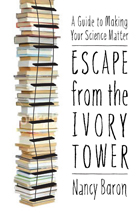 Escape from the Ivory Tower: A Guide to Making Your Science Matter
Nancy Baron
Island Press, 2010 Most scientists and researchers aren’t prepared to talk to the press or to policymakers—or to deal with backlash. Many researchers have the horror stories to prove it. What’s clear, according to Nancy Baron, is that scientists, journalists and public policymakers come from different cultures. They follow different sets of rules, pursue different goals, and speak their own language. To effectively reach journalists and public officials, scientists need to learn new skills and rules of engagement. No matter what your specialty, the keys to success are clear thinking, knowing what you want to say, understanding your audience, and using everyday language to get your main points across.
In this practical and entertaining guide to communicating science, Baron explains how to engage your audience and explain why a particular finding matters. She explores how to ace your interview, promote a paper, enter the political fray, and use new media to connect with your audience. The book includes advice from journalists, decision makers, new media experts, bloggers and some of the thousands of scientists who have participated in her communication workshops. Many of the researchers she has worked with have gone on to become well-known spokespeople for science-related issues. Baron and her protégées describe the risks and rewards of “speaking up,” how to deal with criticism, and the link between communications and leadership. The final chapter, ‘Leading the Way’ offers guidance to scientists who want to become agents of change and make your science matter. Whether you are an absolute beginner or a seasoned veteran looking to hone your skills, Escape From the Ivory Tower can help make your science understood, appreciated and perhaps acted upon.
Escape from the Wasteland: Romanticism and Realism in the Fiction of Mishima Yukio and Oe Kenzaburo
Susan Napier
Harvard University Press, 1991 Nobel Prize winner Oe Kenzaburo and the ever-disturbing Mishima Yukio have explored twentieth-century Japanese alienation with an unsparing eye and savage humor. In Escape from the Wasteland, Susan J. Napier examines their vivid and often perverse depictions of sex, impotence, emperor worship, and violence. For new readers of Oe and Mishima, this is an indispensable guide. For critics and scholars, it is the benchmark study.
 Escape from Vichy: The Refugee Exodus to the French Caribbean
Eric T. Jennings
Harvard University Press, 2018 In the early years of World War II, thousands of political refugees traveled from France to Vichy-controlled Martinique in the French Caribbean, en route to what they hoped would be safer shores in North, Central, and South America. While awaiting transfer from the colony, the exiles formed influential ties—with one another and with local black dissidents. Escape from Vichy recounts this flight from the refugees’ perspectives, using novels, unpublished diaries, archives, memoirs, artwork, and other materials to explore the unlikely encounters that fueled an anti-fascist artistic and intellectual movement.
The refugees included Spanish Republicans, anti-Nazi Germans and Austrians, anti-fascist Italians, Jews from across Europe, and others fleeing violence and repression. They were met with hostility by the Vichy government and rejection by the nations where they hoped to settle. Martinique, however, provided a site propitious for creative ferment, where the revolutionary Victor Serge conversed with the anthropologist Claude Lévi-Strauss, and the Surrealist André Breton met Negritude thinkers René Ménil and Aimé and Suzanne Césaire. As Eric T. Jennings shows, these interactions gave rise to a rich current of thought celebrating blackness and rejecting racism.
What began as expulsion became a kind of rescue, cut short by Washington’s fears that wolves might be posing in sheep’s clothing.
Escape Routes: Control and Subversion in the Twenty-First Century
Dimitris Papadopoulos, Niamh Stephenson, and Vassilis Tsianos
Pluto Press, 2008 Illegal migrants who evade detection, creators of value in insecure and precarious working conditions and those who refuse the constraints of sexual and biomedical classifications: these are the people who manage to subvert power and to craft unexpected sociabilities and experiences. Escape Routes shows how people can escape control and create social change by becoming imperceptible to the political system of Global North Atlantic societies.
Escape Through the Pyrenees
Lisa Fittko
Northwestern University Press, 2000 Though it reads like a suspense novel, this memoir is Lisa Fittko's extraordinary story of life as an "enemy alien" in France before and after the German invasion of 1940. Escaping a French prison, Fittko and her husband found their way to the Pyrenees and, while awaiting permission to enter Spain, helped hundreds of refugees, including Walter Benjamin, escape deportation, torture, and death at the hands of the Nazis.
Escape to Manila: From Nazi Tyranny to Japanese Terror
Frank Ephraim. Foreword by Stanley A. Karnow
University of Illinois Press, 2002 A harrowing account of Jewish refugees in the Philippines With the rise of Nazism in the 1930s more than a thousand European Jews sought refuge in the Philippines, joining the small Jewish population of Manila. When the Japanese invaded the islands in 1941, the peaceful existence of the barely settled Jews filled with the kinds of uncertainties and oppression they thought they had left behind. In this book Frank Ephraim, who fled to Manila with his parents, gathers the testimonies of thirty-six refugees, who describe the difficult journey to Manila, the lives they built there upon their arrival, and the events surrounding the Japanese invasion. Combining these accounts with historical and archival records, Manila newspapers, and U.S. government documents, Ephraim constructs a detailed account of this little-known chapter of world history.
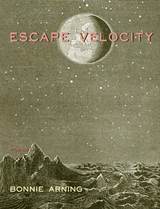 Escape Velocity
Bonnie Arning
University Press of Colorado, 2017 From the moment of a marriage’s heated inception to its period of luminous crowding and onward into distance and darkness, Bonnie Arning’s Escape Velocity asks if it’s possible to exist outside the only universe we’ve ever known. In modes both lyric and narrative, we are given a peephole into the height and decline of a marriage that begins beneath the moving lights of Las Vegas, Nevada, and traverses the devastating terrain of gambling, miscarriage, infidelity, and violence. Arning gives voice to divergent aspects of love and violence through her use of math problems, erasures, dictionary entries, structured stanzas, and sprawling free verse. This multiplicity of forms comes together to explore everything from pop culture references of domestic violence to cultural notions of victims and victimhood. However dark, collectively these poems tell a love story—an acceptance of our capability to love those who hurt us, but also the love-of-self required to slowly and steadily reach "the velocity to be everleaving." In the tradition of Eavan Boland and Louise Glück, Arning wrestles down and examines the terrible without flinching. We journey with her, engrossed by each difficult truth: a precipice near which we are both terrified to stand and transfixed by its unnerving insistence on beauty.
 Escape Velocity: A Charles Portis Miscellany
Jay Jennings
Butler Center for Arkansas Studies, 2012 For those who care about literature or simply love a good laugh (or both), Charles Portis has long been one of America's most admired novelists. His 1968 novel True Grit is fixed in the contemporary canon, and four more have been hailed as comic masterpieces. Now, for the first time, his other writings--journalism, travel stories, short fiction, memoir, and even a play--have been brought together in Escape Velocity: A Charles Portis Miscellany, his first new book in more than twenty years. All the familiar Portis elements are here: picaresque adventures, deadpan humor, an expert eye for detail and keen ear for the spoken word, and encounters with oddball characters both real and imagined. The collection encompasses the breadth of his fifty-year writing career, from his gripping reportage of the civil rights movement for the New York Herald Tribune to a comic short story about the demise of journalism in the 21st century. New to even the most ardent fan is his three-act play, Delray's New Moon, performed onstage in 1996 and published here for the first time. Whether this is your first encounter with the world of Portis or a long-awaited return to it, you'll agree with critic Ron Rosenbaum--whose essay appears here alongside tributes by other writers--that Portis "will come to be regarded as the author of classics on the order of a twentieth-century Mark Twain, a writer who captures the soul of America."
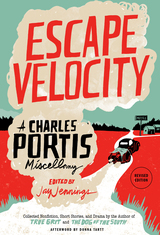 Escape Velocity: A Charles Portis Miscellany
Charles Portis
Butler Center for Arkansas Studies, 2021 For those who care about literature or simply love a good laugh (or both), Charles Portis has long been one of America’s most admired novelists. His 1968 novel True Grit is fixed in the contemporary canon, and four more have been hailed as comic masterpieces. For the first time, his other writings—journalism, travel stories, short fiction, memoir, and even a play—were brought together in Escape Velocity: A Charles Portis Miscellany, published in 2012 as his first new book in more than twenty years. This revised edition includes a new afterword by best-selling author Donna Tartt, who first published her remembrance in the New York Times following Portis’s death in 2020. All the familiar Portis elements are in this collection: picaresque adventures, deadpan humor, an expert eye for detail and keen ear for the spoken word, and encounters with oddball characters both real and imagined. The collection encompasses the breadth of his fifty-year writing career, from his gripping reportage of the civil rights movement for the New York Herald Tribune to a comic short story about the demise of journalism in the twenty-first century. His three-act play, Delray’s New Moon, was performed onstage in 1996 and published in Escape Velocity for the first time. Whether this is your first journey to the world of Portis or a long-awaited return to it, you’ll agree with critic Ron Rosenbaum—whose essay appears here alongside tributes by other writers—that Portis “will come to be regarded as the author of classics on the order of a twentieth-century Mark Twain, a writer who captures the soul of America.”
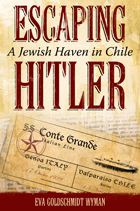 Escaping Hitler: A Jewish Haven in Chile
Eva Goldschmidt Wyman
University of Alabama Press, 2013 Escaping Hitler is the personal story of Eva Wyman and her family’s escape from Nazi Germany to Chile in the sociohistorical context of 1930s and 1940s, a time when the Chilean Nazi party had an active presence in the country’s major institutions. Based primarily on interviews with German Jewish refugees and family correspondence, Eva Goldschmidt Wyman provides an intimate account of Jews in Germany in the 1930s as Nazi controls tightened and family members were taken to Riga concentration camp. Wyman recounts Kristallnacht in Stuttgart, where her father was principal of the Jewish school, his imprisonment in Dachau, and his release and immigration to Great Britain. Escaping Hitler details the family’s escape from Germany and subsequent life in Chile, providing an intimate look at daily life on the steam ship Conte Grande during the voyage from Italy to Chile in 1939, Nazi espionage and anti-Semitic activity in Chile, and the Nazi influence in South America in general. Recounted in an intimate and personal style, Escaping Hitler immerses the reader in an extraordinary chapter of contemporary Jewish history both inside Germany and South America.
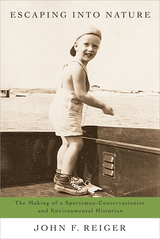 Escaping into Nature: The Making of a Sportsman-Conservationist and Environmental Historian
John F. Reiger
Oregon State University Press, 2013 “It was only by escaping into nature that I could obtain the peace and harmony I sought.” —from the Introduction
In Escaping into Nature, prominent wildlife conservationist and environmental historian John Reiger shares his story of an angler and hunter who found a cause and a calling and combined them for his life’s work.
John Reiger’s outdoor adventures as a young man primed him for the teachings of the great sportsmen-conservationists of the past, particularly George Bird Grinnell, Theodore Roosevelt, and Aldo Leopold. Inspired by these conservation giants, Reiger left the security of a tenured professorship to serve as executive director of the Connecticut Audubon Society where he, sometimes controversially, put his ideals into practice. Later, he resumed his academic career to illuminate the lives of early wildlife conservationists, visionaries who continue to inspire us to care deeply about the future of the natural world.
Abused psychologically within his family in his early years, Reiger found solace in nature. Though he first entered the outdoors as an escape from his unpleasant circumstances, he soon found the study and pursuit of insects, fishes, and birds to be exciting ends in themselves. He came to believe that it was only by participating in the life and death of other creatures that one could learn to truly value the natural world, be a part of it, and be inspired to work for its conservation.
John Reiger’s autobiography is also the story of his own developing fascination with America’s past, especially as it relates to human interaction with the natural world; his desire to share that passion with others; and his experiences on the road to becoming a nationally recognized scholar. The twists and turns of that journey, and his accounts of the people—and of the wild creatures—who helped him along the way, will appeal to history enthusiasts and nature lovers alike.
 Escaping Into Words: A Creative Writing Workbook
Vicente Concilio and Caroline Vetori, translated by Ashley Lucas
Michigan Publishing, 2025 Escaping Into Words: A Creative Writing Workbook is an English translation of a book originally published for incarcerated women in Brazil. Vicente Concilio and Caroline Vetori at the state university of Santa Catarina (UDESC) in Florianópolis, Brazil, were facilitating a theatre workshop at their local women’s prison when the COVID-19 pandemic interrupted their work. All volunteers were prevented from entering the prison for nearly two years. Concilio and Vetori wrote this book to stay connected to the imprisoned women, using poetic language to prompt them to write about their lives, thoughts, and ideas. Graphic designer Anelize Zimmermann created vibrant artwork to complement the text and invite readers to write and engage. The workbook was distributed for free in the prison in Florianópolis and in an open access edition online.
Since 2016, the prison theatre program at UDESC has been a part of an international exchange program with the University of Michigan’s Prison Creative Arts Project (PCAP). Faculty and students visit classes at each other’s universities and visit theatre workshops in prisons in both nations. Ashley Lucas’s translation of Escaping Into Words extends this exchange and makes this text available to writers in Michigan prisons through PCAP.
The open access version of this book makes it possible for anyone with an interest in creative writing to explore the world and their own thoughts using this innovative and beautiful text. Those with incarcerated loved ones using the book can access the online edition or purchase a paperback edition to share this experience.
 Escaping Kakania: Eastern European Travels in Colonial Southeast Asia
Jan Mrázek
Central European University Press, 2024 Escaping Kakania is about fascinating characters—soldiers, doctors, scientists, writers, painters—who traveled from their eastern European homelands to colonial Southeast Asia. Their stories are told by experts on different countries in the two regions, who bring diverse approaches into a conversation that crosses disciplinary and national borders. The 14 chapters deal with the diverse encounters of eastern Europeans with the many faces of colonial southeast Asia. Some essays directly engage with post-colonial studies, contributing to an ongoing critical re-evaluation of eastern European “semi-peripheral” (non-)involvement in colonialism. Other chapters disclose a range of perspectives and narratives that illuminate the plurality of the travelers’ positions while reflecting on the specificity of the eastern European experience. The travellers moved—as do the chapter authors—between two regions that are off-centre, in-between, shiftingly “Eastern,” and disorientingly heterogeneous, thus complicating colonial and postcolonial notions of “Europe,” “East,” and East-West distinctions. Both at home and overseas, they navigated among a multiplicity of peoples, “races,” and empires, Occidents and Orients, fantasies of the Self and the Other, adopting/adapting/mimicking/rejecting colonialist identities and ideologies. They saw both eastern Europe and southeast Asia in a distinctive light, as if through each other—and so will the readers of Escaping Kakania.
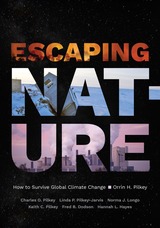 Escaping Nature: How to Survive Global Climate Change
Orrin H. Pilkey, Charles O. Pilkey, Linda P. Pilkey-Jarvis, Norma J. Longo, Keith C. Pilkey, Fred B. Dodson, and Hannah L. Hayes
Duke University Press, 2024 Industrial and agricultural greenhouse gas emissions are rapidly warming Earth’s climate, unleashing rising seas, ocean acidification, melting permafrost, powerful storms, wildfires, floods, deadly heat waves, droughts, tsunamis, food shortages, and armed conflict over shrinking water supplies while reducing nutritional levels in crops. Billions of people will become climate refugees. Hotter temperatures will allow tropical diseases to spread into temperate regions. Higher levels of CO2, allergens, dust, and other particulate matter will impair our physical and mental health and even reduce our cognitive abilities. Climate change disproportionately affects the world’s poor. It also harms Nature, and could ultimately trigger a sixth mass extinction. In Escaping Nature, Orrin H. Pilkey and his coauthors offer concrete suggestions for how to respond to the threats posed by global climate change. They argue that while we wait for the world’s governments to get serious about mitigating climate change we can adapt to a hotter world through technological innovations, behavioral changes, nature-based solutions, political changes, and education.
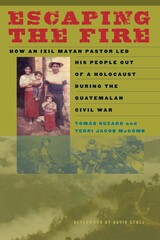 Escaping the Fire: How an Ixil Mayan Pastor Led His People Out of a Holocaust During the Guatemalan Civil War
By Tomás Guzaro and Terri Jacob McComb
University of Texas Press, 2010 During the height of the Guatemalan civil war, Tomás Guzaro, a Mayan evangelical pastor, led more than two hundred fellow Mayas out of guerrilla-controlled Ixil territory and into the relative safety of the government army's hands. This exodus was one of the factors that caused the guerrillas to lose their grip on the Ixil, thus hastening the return of peace to the area. In Escaping the Fire, Guzaro relates the hardships common to most Mayas and the resulting unrest that opened the door to civil war. He details the Guatemalan army's atrocities while also describing the Guerrilla Army of the Poor's rise to power in Ixil country, which resulted in limited religious freedom, murdered church leaders, and threatened congregations. His story climaxes with the harrowing vision that induced him to guide his people out of their war-torn homeland. Guzaro also provides an intimate look at his spiritual pilgrimage through all three of Guatemala's main religions. The son of a Mayan priest, formerly a leader in the Catholic Church, and finally a convert to Protestantism, Guzaro, in detailing his religious life, offers insight into the widespread shift toward Protestantism in Latin America over the past four decades. Riveting and highly personal, Escaping the Fire ultimately provides a counterpoint to the usual interpretation of indigenous agency during the Guatemalan civil war by documenting the little-studied experiences of Protestants living in guerrilla-held territory.
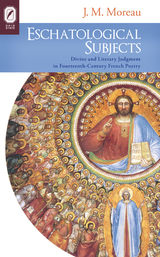 Eschatological Subjects: Divine and Literary Judgment in Fourteenth-Century French Poetry
J. M. Moreau
Ohio State University Press, 2014 Eschatological Subjects: Divine and Literary Judgment in Fourteenth-Century French Poetry takes an innovative approach to medieval eschatology by examining how poets cast themselves in the scene of judgment as defendants summoned to answer to the Almighty for the sins of their writing. Since medieval Europeans lived in perpetual anxiety of divine judgment, constantly surrounded by reminders in art and literature, author J. M. Moreau shows that this is a natural extension of medieval life.
But Eschatological Subjects goes even further to demonstrate the largely unrecognized duality of this judge figure: not just God, the judge is also the imperious and imperfect human reader. The simultaneous divine and human judgments in (and of) French poetry reveal much about the ethical stakes of writing vernacular poetry in the later Middle Ages and, most importantly, about the relationships between authors and audiences.
Focusing on Guillaume de Deguileville, Guillaume de Machaut, and Jean Froissart (each of whom composed scenes in which they appear on trial before God), Moreau contributes important new insights on the complex “trial process” of later medieval literature, in which poetic authority and fame depended on the poet’s ability to defend himself before a fearful court of reader opinion.
Eschatology: Death and the Eternal Life (Second Edition)
Joseph Ratzinger
Catholic University of America Press, 2007 Originally published in English in 1988, Joseph Ratzinger's Eschatology remains internationally recognized as a leading text on the "last things"—heaven and hell, purgatory and judgment, death and the immortality of the soul. This highly anticipated second edition includes a new preface by Joseph Ratzinger/Pope Benedict XVI and a supplement to the bibliography by theologian Peter A. Casarella.
Eschatology presents a balanced perspective of the doctrine at the center of Christian belief—the Church's faith in eternal life. Recognizing the task of contemporary eschatology as "to marry perspectives, so that person and community, present and future, are seen in their unity," Joseph Ratzinger brings together recent emphasis on the theology of hope for the future with the more traditional elements of the doctrine. His book has proven to be as timeless as it is timely.
ESG Innovation for Sustainable Manufacturing Technology: Applications, designs and standards
Wai Yie Leong
The Institution of Engineering and Technology, 2024 In an era defined by unprecedented environmental challenges, social inequalities, and corporate responsibility, the concept of Environmental, Social, and Governance (ESG) has emerged as a transformative force. It is a set of practices used to evaluate the operational performance of a company or industry sector as it relates to social and environmental impact.
ESJ vol 113 num 3
The University of Chicago Press
University of Chicago Press Journals, 2013
ESJ vol 113 num 4
The University of Chicago Press
University of Chicago Press Journals, 2013
ESJ vol 114 num 1
The University of Chicago Press
University of Chicago Press Journals, 2013
ESJ vol 114 num 2
The University of Chicago Press
University of Chicago Press Journals, 2013
ESJ vol 114 num 3
The University of Chicago Press
University of Chicago Press Journals, 2014
ESJ vol 114 num 4
The University of Chicago Press
University of Chicago Press Journals, 2014
ESJ vol 115 num 1
The University of Chicago Press
University of Chicago Press Journals, 2014
ESJ vol 115 num 2
The University of Chicago Press
University of Chicago Press Journals, 2014
ESJ vol 115 num 3
The University of Chicago Press
University of Chicago Press Journals, 2015
ESJ vol 115 num 4
The University of Chicago Press
University of Chicago Press Journals, 2015
ESJ vol 116 num 1
The University of Chicago Press
University of Chicago Press Journals, 2015
ESJ vol 116 num 2
The University of Chicago Press
University of Chicago Press Journals, 2015
ESJ vol 116 num 3
The University of Chicago Press
University of Chicago Press Journals, 2016
ESJ vol 116 num 4
The University of Chicago Press
University of Chicago Press Journals, 2016
ESJ vol 117 num 1
The University of Chicago Press
University of Chicago Press Journals, 2016
ESJ vol 117 num 2
The University of Chicago Press
University of Chicago Press Journals, 2016
ESJ vol 117 num 3
The University of Chicago Press
University of Chicago Press Journals, 2017
ESJ vol 117 num 4
The University of Chicago Press
University of Chicago Press Journals, 2017
ESJ vol 118 num 1
The University of Chicago Press
University of Chicago Press Journals, 2017
ESJ vol 118 num 2
The University of Chicago Press
University of Chicago Press Journals, 2017
ESJ vol 118 num 3
The University of Chicago Press
University of Chicago Press Journals, 2018
ESJ vol 118 num 4
The University of Chicago Press
University of Chicago Press Journals, 2018
ESJ vol 119 num 1
The University of Chicago Press
University of Chicago Press Journals, 2018
ESJ vol 119 num 2
The University of Chicago Press
University of Chicago Press Journals, 2018
ESJ vol 119 num 3
The University of Chicago Press
University of Chicago Press Journals, 2019
ESJ vol 119 num 4
The University of Chicago Press
University of Chicago Press Journals, 2019
ESJ vol 120 num 1
The University of Chicago Press
University of Chicago Press Journals, 2019
ESJ vol 120 num 2
The University of Chicago Press
University of Chicago Press Journals, 2019
ESJ vol 120 num 3
The University of Chicago Press
University of Chicago Press Journals, 2020 This is volume 120 issue 3 of The Elementary School Journal. The Elementary School Journal (ESJ) has served researchers, teacher educators, and practitioners in the elementary and middle school education for more than one hundred years. ESJ publishes peer-reviewed articles that pertain to both education theory and research and their implications for teaching practice. In addition, ESJ presents articles that relate the latest research in child development, cognitive psychology, and sociology to school learning and teaching.
ESJ vol 120 num 4
The University of Chicago Press
University of Chicago Press Journals, 2020
ESJ vol 121 num 1
The University of Chicago Press
University of Chicago Press Journals, 2020
ESJ vol 121 num 2
The University of Chicago Press
University of Chicago Press Journals, 2020
ESJ vol 121 num 3
The University of Chicago Press
University of Chicago Press Journals, 2021
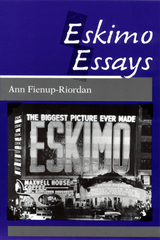 Eskimo Essays: Yup'ik Lives and How We See Them
Ann Fienup-Riordan
Rutgers University Press, 1991 Eskimo Essays introduces the reader to important aspects of the ideology and practice of the Yup’ik Eskimos of western Alaska, past and present. The essays point the way toward a fuller recognition of how Yup’ik Eskimos differ from the popular Western image of the Eskimo that was born largely without reference to Yup’ik reality. By describing the reality of Yup’ik life, Eskimo Essays extends our understanding of Esimos in general and Yup’ik Eskimos in particular. Ann Fienup-Riordan argues that Western observers have simultaneously naturalized Eskimos as paragons of simplicity and virtue and Western imperialism. This process has often ignored Eskimo concepts of society, history, and personhood. An original assumption of similarity to Western society has profoundly affected the current Euro-American view of Eskimo history and action. Non-natives have taken an idealized Western individual, dressed that person up in polar garb, and then assumed they understood the garment’s maker. The result is a presentation of Eskimo society that often tells us more about the meaning we seek in our own. Moreover, modern Eskimos have risen to the challenge and to some extent become what we have made them. Bridging the gap between informed scholarships and popular concepts, Fienup-Riordan provides a compelling and fresh presentation of Yup’ik life—cosmology, the missionary experience, attitudes toward conservation, Eskimo art, the legal system, warfare, and ceremonies.
The Eskimo Girl and the Englishman
Edna Wilder
University of Alaska Press, 2009 The Eskimo Girl and the Englishman is a sequel to the delightful story Once Upon an Eskimo Time, which recounts the remarkable life of Minnie and her Eskimo mother as she comes of age in a traditional village on Alaska’s western coast. Resuming the tale on the day Minnie encounters her first white man, The Eskimo Girl and the Englishman relates the next century of Minnie’s adventurous life—painting a picture of early twentieth-century village life as Minnie and her Englishman marry and find the determination, strength, and courage to live life in the face of tragedy, rapidly changing technology, and unrelenting hardship along the Bering Sea. Accompanied by photographs of early Eskimo village life, the narrative poignantly captures a sense of a long-lost way of life on the Seward Peninsula.
Eskimo Storyteller: Folktales from Noatak, Alaska New Edition
Edwin Hall
University of Alaska Press, 1999 Now a classic in northern literature, The Eskimo Storyteller brings to life the words of Eskimo elders for a new generation of readers. This collection of folktales from northwest Alaska includes stories populated by amazing creatures, hard-bitten hunters, and strong-minded women. Two master storytellers, Edna Hunnicutt and Paul Monroe, introduce readers to the guiding principles of daily life in the Arctic and chronicle the devastating results when those principles are violated. Elegant line drawings by Claire Fejes illustrate the characters and key events.
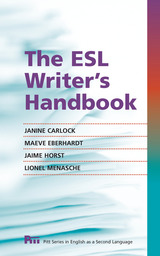 The ESL Writer's Handbook
Janine Carlock, Maeve Eberhardt, Jaime Horst, Lionel Menasche
University of Michigan Press, 2010
The ESL Writer’s Handbook is a reference work for ESL students who are taking college-level courses. Because its purpose is to provide help with the broad variety of writing questions students may have when working on school assignments, the text focuses on
English for Academic Purposes. Unlike other handbooks on the market, this book’s sole purpose is to address the issues of second language learners.
This spiral-bound Handbook complements a student writer’s dictionary, thesaurus, and grammar reference book. It would be suitable as a text for an advanced ESL writing course when used together with the companion Workbook (978-0-472-03404-8). The Handbook is concise and easily navigated; is accessible, with clear and direct explanatory language; features information on both APA and MLA styles (including a sample paper for each); and includes many examples from ESL student writers to provide realistic models.
Included as special features in the Handbook are:
• The topic selection is based on ESL writers’ needs as observed by the authors over many years.
• The coverage of topics is more complete than the limited amount usually provided for ESL writers in first language or L1 handbooks.
• The explanatory language is appropriate for ESL students, in contrast to the more complex and idiomatic language of other English handbooks.
• The level of detail is more manageable for ESL students, compared to what is in other English handbooks.
- Many of the examples of paragraphs, essays, research papers, and exercise sentences were written by ESL students; this encourages users of this Handbook to realize that they can also become effective writers.
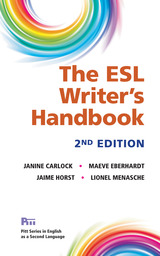 The ESL Writer's Handbook, 2nd Ed.
Janine Carlock, Maeve Eberhardt, Jaime Horst, Lionel Menasche
University of Michigan Press, 2018 The ESL Writer’s Handbook is a reference work for ESL students who are taking college-level courses. Because its purpose is to provide help with the broad variety of writing questions students may have when working on school assignments, the text focuses on English for Academic Purposes. Unlike other handbooks on the market, this book’s sole purpose is to address the issues of second language learners. The spiral-bound Handbook complements a student writer’s dictionary, thesaurus, and grammar reference book. It would be suitable as a text for an advanced ESL writing course when used together with the companion Workbook (978-0-472-03726-1). The new edition features significant revisions to Sections 3 and 4; in particular, both APA and MLA style guides have been updated and new sample papers for each are included. The new edition includes new and revised exercises and many new samples of student writing. Like its predecessor, the 2nd Edition has these special features: - The topic selection is based on ESL writers’ needs as observed by the authors over many years.
- The coverage of topics is more complete than the limited amount usually provided for ESL writers in first language or L1 handbooks.
- The explanatory language is appropriate for ESL students, in contrast to the more complex and idiomatic language of other English handbooks.
- Many of the examples of paragraphs, essays, research papers, and exercise sentences were written by ESL students to help users realize that they too can become effective writers.
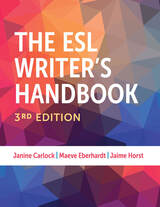 The ESL Writer's Handbook, 3rd Edition
Janine Carlock, Maeve Eberhardt, Jaime Horst
University of Michigan Press, 2025 The 3rd edition of The ESL Writer’s Handbook continues to be a valuable resource that offers non-native English speakers, particularly international students, a foundation in the basics of the academic writing genre they need to succeed in high school– or college-level writing. By focusing on English for Academic Purposes, it helps address the broad variety of writing questions students may have while working on school assignments. It can act as a complement to a student’s dictionary, thesaurus, and grammar reference book, or as a core text in an advanced-level ESL writing course. With explanatory language that avoids unnecessary idioms and incorporates writing examples from real international students, The ESL Writer’s Handbook will help students build their confidence in English language writing. In addition to updated style guides, sample student papers, writing examples, and exercises, the 3rd edition highlights “tech tips” on different technologies that may be useful to students, explains inclusive language, and expands the section on taking notes as a research tool. With this handbook, students will learn: - The concept of genre and apply it to unpacking assignments and writing effectively.
- The process for generating ideas, structuring those ideas into a paper, and checking over a paper before turning it in.
- Five common patterns for organizing an academic essay: narrative, process, comparison/contrast, cause and effect, and argument.
- Different steps for creating a good research paper, including major citation styles.
- Guidance for addressing the grammar, punctuation, and style issues most often encountered by international students writing in English.
- How to differentiate between other types of writing U.S. undergraduate students are expected to complete, such as emails, resumes, cover letters, and personal statements.
CEFR Levels: B1 –C2
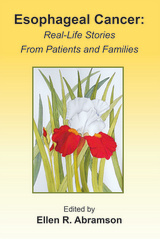 Esophageal Cancer: Real life stories from patients and families
Edited by Ellen R. Abramson
Michigan Publishing, 2015 This book presents the stories of eleven patients and family members who received the diagnosis of esophageal cancer. The stories, provided by esophageal cancer survivors, illustrate some of the setbacks and some of the triumphs, that these individuals and their families encountered. All of these patients underwent a remarkable surgical procedure known as an esophagectomy. During this operation, the majority of the esophagus is removed. In order to restore swallowing, the stomach is reconfigured into a tube that is repositioned in the chest and neck and sutured to the remaining esophagus. The stories convey courage and strength in the face of a major life-changing event and its consequences. The authors describe in detail what the experience was like for themselves and their loved ones. Their stories are inspiring and offer hope to others facing this illness. Book sales support patient and family education in the Thoracic Surgery section of the University of Michigan Health System.
Esotericism, Art and Imagination
Arthur Versluis
Michigan State University Press, 2008
Esotericism, Art, and Imagination is a uniquely wide-ranging collection of articles by scholars in the field of Western esotericism, focusing on themes of poetry, drama, film, literature, and art. Included here are articles illuminating such diverse topics as the Gnostic fiction of Philip Pullman, alchemical images, the Tarot, surrealism, esoteric films, and much more. This collection reveals the richness and complexity of the intersections between esotericism, artistic creators, and their works. Authors include Joscelyn Godwin, Cathy Gutierrez, M. E. Warlick, Eric Wilson, and many others.
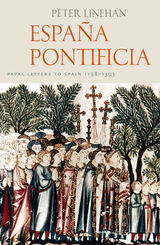 Espana Pontifica: Papal Letters to Spain 1198-1303
Peter Linehan
Catholic University of America Press, 2022 Peter Linehan (+2020) followed his survey of original papal letters in Portugal, Portugalia pontifica 1198-1417 (2013) with the present volume, España Pontifica, that covers papal letters to Spanish recipients from Pope Innocent II (1198-1216) to Pope Boniface VIII (+1303). This volume will provide students of the medieval papacy and the Spanish church with an invaluable research tool to explore the relationship between Rome and Spain during the crucial period of the Spanish Reconquistà after the battles of Navas de Tolosa (1212) to the capture of Seville (1248).
Linehan spent his career cataloguing papal letters from more than sixty Spanish repositories. For the past sixty years the Vatican has also been engaged in publishing surveys of original papal letters preserved from various European archives. However, this volume includes material that has not been included in these surveys.
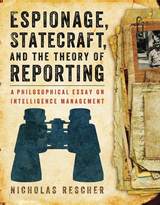 Espionage, Statecraft, and the Theory of Reporting: A Philosophical Essay on Intelligence Management
Nicholas Rescher
University of Pittsburgh Press, 2017 Everything we know about what goes on in the world comes to us through reports, information transmitted through human communication. We rely on reports, which can take any number of forms, to convey useful information, and we derive knowledge from that information. It's no surprise, then, that reporting has many philosophical dimensions. Because it plays such a major role in knowledge management, as Nicholas Rescher argues, the epistemology of reporting not only deserves our attention but also sheds important light on how we understand the theory of knowledge. This book offers a clear, accessible introduction to the theory of reporting, with a special emphasis on national security, particularly military and diplomatic reporting, drawing on examples from historical accounts of espionage and statecraft from the Second World War. Rescher explores the various issues and problems related to the production and reception of reports—including reporter expertise and trustworthiness, transmission modalities, confidentiality, cognitive importance, and the interpretation, evaluation, and utilization of reports—providing readers with a distinctive and well organized philosophical clarification of some central features of the theory of reporting.
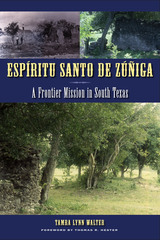 Espíritu Santo de Zúñiga: A Frontier Mission in South Texas
By Tamra Lynn Walter
University of Texas Press, 2007 San Antonio Conservation Society Citation, 2009 In the early part of the eighteenth century, the Spanish colonial mission Espíritu Santo de Zúñiga was relocated from far south Texas to a site along the Guadalupe River in Mission Valley, Victoria County. This mission, along with a handful of others in south Texas, was established by the Spaniards in an effort to Christianize and civilize the local Native American tribes in the hopes that they would become loyal Spanish citizens who would protect this new frontier from foreign incursions. With written historical records scarce for Espíritu Santo, Tamra Walter relies heavily on material culture recovered at this site through a series of recent archaeological investigations to present a compelling portrait of the Franciscan mission system. By examining findings from the entire mission site, including the compound, irrigation system, quarry, and kiln, she focuses on questions that are rarely, if ever, answered through historical records alone: What was daily life at the mission like? What effect did the mission routine have on the traditional lifeways of the mission Indians? How were both the Indians and the colonizers changed by their frontier experiences, and what does this say about the missionization process? Walter goes beyond simple descriptions of artifacts and mission architecture to address the role these elements played in the lives of the mission residents, demonstrating how archaeology is able to address issues that are not typically addressed by historians. In doing so, she presents an accurate portrait of life in South Texas at this time. This study of Mission Espíritu Santo will serve as a model for research at similar early colonial sites in Texas and elsewhere.
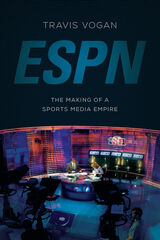 ESPN: The Making of a Sports Media Empire
Travis Vogan
University of Illinois Press, 2015 Once a shoestring operation built on plywood sets and Australian rules football, ESPN has evolved into a media colossus. A genius for cross-promotion and its near-mystical rapport with its viewers empower the network to set agendas and create superstars, to curate sports history even as it mainstreams the latest cultural trends. Travis Vogan teams archival research and interviews with an all-star cast to pen the definitive account of how ESPN turned X's and O's into billions of $$$. Vogan's institutional and cultural history focuses on the network since 1998, the year it launched a high-motor effort to craft its brand and grow audiences across media platforms. As he shows, innovative properties like SportsCentury, ESPN The Magazine, and 30 for 30 built the network's cultural caché. This credibility, in turn, propelled ESPN's transformation into an entity that lapped its run-of-the-mill competitors and helped fulfill its self-proclaimed status as the "Worldwide Leader in Sports." Ambitious and long overdue, ESPN: The Making of a Sports Media Empire offers an inside look at how the network changed an industry and reshaped the very way we live as sports fans.
An Essay Concerning the Understanding, Knowledge, Opinion, and Assent
John Locke
Harvard University Press Dr. Benjamin Rand of the Harvard Philosophical Department has added the original draft of Locke’s “Essay Concerning the Understanding” as the crowning achievement to his numerous discoveries and works of the unpublished writings of the great English philosophers. This draft was written in 1671, whereas the “Essay” did not appear in a first edition until 1690. Scholars may now for the first time trace the development of Locke’s doctrines by a comparison of the two. As a help in such study, Dr. Rand has provided the work with full critical and editorial matter. The book will be found indispensable to every student of English philosophy and particularly of Locke’s doctrines.
 Essay Film and Narrative Techniques: Screen-writing Non-fiction
Edited by Romana Turina and Kiki Tianqi Yu
Intellect Books, 2025 Bringing together filmmakers and scholars, this volume unpacks the evolving language of screenwriting in documentary and experimental cinema.
Uniting filmmakers and practice-led researchers, Essay Film and Narrative Techniques: Screen-writing Non-fiction explores the evolving language of essay film through various methods of narration, including production diaries, self-critiques, interviews, and theoretical analyses. Including canonical works and unconventional approaches, this collection emphasizes how essay films blur the lines between personal expression and collective storytelling.
In this volume, renowned scholars and practitioners unpack the conceptual and contextual dimensions of screenwriting for essay film, considering its role as both a cinematic and research tool. Whether reflecting on the personal camera or hybrid creative methodologies, the essays provide invaluable insights into how essay films are written and realized.
With its interdisciplinary scope and innovative approach, this work is a beneficial resource for academics, filmmakers, and students of documentary and experimental cinema, offering a nuanced understanding of how screenwriting shapes nonfiction storytelling.
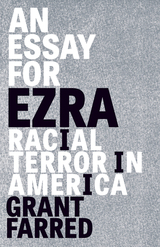 An Essay for Ezra: Racial Terror in America
Grant Farred
University of Minnesota Press, 2021 An intensely personal, and philosophical, account of why white America’s racial unconscious is not so unconscious
An Essay for Ezra is a critique of terror that begins but by no means ends with the presidency of Donald J. Trump. A father addresses his son and a boy shares his observations in a dynamic dialogistic exchange that is a commentary of and for its time, taking the measure of racial terror and of white supremacy both in our moment and as a historical phenomenon. Framed through the experiences of the author’s biracial son, An Essay for Ezra is intensely personal while also powerfully universal. Drawing on the social and political thought of James Baldwin and Martin Luther King, Grant Farred examines the temptation and the perils of essentialism and the need to discriminate—to engage the black mind as much as the black body. With that dialectic as his starting point, Farred engages the ideas of Jameson, Barthes, Derrida, Adorno, Kant, and other thinkers to derive an ethics of being in our time of social peril. His antiessentialist racial analysis is salient, especially when he deploys Dave Chappelle as a counterpoint to Baldwin—and Chappelle’s brilliant comic philosophic voice jabs at both racial and gender identity. Standing apart for its willingness to explore terror in all its ambivalence, this theoretical reflection on racism, knowledge, ethics, and being in our neofascist present brings to bear the full weight of philosophical inquiry and popular cultural critique on black life in the United States.
An Essay in Aid of a Grammar of Assent
John Henry Newman
University of Notre Dame Press, 1979 This classic of Christian apologetics seeks to persuade the skeptic that there are good reasons to believe in God even though it si impossible to understand the Deity fully. First written over a century ago, the Grammar of Assent speaks as powerfully to us today as it did to its first readers. Because of the informal, non-technical character of Newman's work, it still retains its immediacy as an invaluable guide to the nature of religious belief. An introduction by Nicholas Lash reviews the background of the Grammar, highlights its principal themes, and evaluates its philosophical originality.
 An Essay on Calcareous Manures
Edmund Ruffin
Harvard University Press The publication in 1832 of An Essay on Calcareous Manures initiated an era of agricultural reform in the ante-bellum South. By 1850 Edmund Ruffin, seconded by John Taylor of Carolina, had effected a transformation of the economy of the upper South from poverty to agricultural prosperity. The essay's importance is not only regional, for in its four editions it presented Ruffin's theories to farmers who were facing the same problems of soil exhaustion in other parts of America. This small book, with its uncompromisingly descriptive title, is a landmark in the history of soil chemistry in the United States.
Ruffin read widely in the literature, mainly European, of agricultural chemistry, and in the 1820's he experimented with ways to make planting pay on his own tidewater Virginia lands. On the basis of his own research and frustrating experience as a farmer, he maintained that the capacity, of soil for enrichment by plant and animal manure is only relative to the original fertility of the soil. In other words, organic manures can only restore earth to what it was prior to cultivation. If land originally lacked the mineral ingredients essential to fertility, it would yield sparingly as long as the minerals were absent.
Ruffin found that uncultivated land in his part of Virginia lacked calcium carbonate, and that most of this same poor soil contained vegetable acid, the cause of its sterility. His solution was to plow in calcareous manure that is, earth containing calcium carbonate thus neutralizing the acid. When Ruffin first had his slaves dig up marl from one of the beds of fossilized shells that underlie much of coastal Virginia, and directed them to apply it to a test patch of his land, which was then planted with corn, he increased his yield by 40 per cent. This amazingly successful experiment led to others, and became what a contemporary of Ruffin called "the first systematic attempt wherein a plain, practical, unpretending farmer...has undertaken to examine into the real composition of the soils which he possesses and has to cultivate."
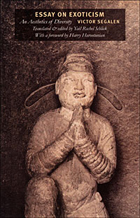 Essay on Exoticism: An Aesthetics of Diversity
Victor Segalen
Duke University Press, 2002 The “Other”—source of fear and fascination; emblem of difference demonized and romanticized. Theories of alterity and cultural diversity abound in the contemporary academic landscape. Victor Segalen’s early attempt to theorize the exotic is a crucial reference point for all discussions of alterity, diversity, and ethnicity.
Written over the course of fourteen years between 1904 and 1918, at the height of the age of imperialism, Essay on Exoticism encompasses Segalen’s attempts to define “true Exoticism.” This concept, he hoped, would not only replace nineteenth-century notions of exoticism that he considered tawdry and romantic, but also redirect his contemporaries’ propensity to reduce the exotic to the “colonial.” His critique envisions a mechanism that appreciates cultural difference—which it posits as an aesthetic and ontological value—rather than assimilating it: “Exoticism’s power is nothing other than the ability to conceive otherwise,” he writes.
Segalen’s pioneering work on otherness anticipates and informs much of the current postcolonial critique of colonial discourse. As such Essay on Exoticism is essential reading for both cultural theorists or those with an interest in the politics of difference and diversity.
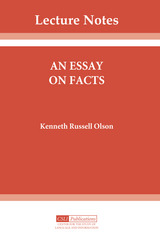 An Essay on Facts
Kenneth Russel Olson
CSLI, 1987 The notion of fact, as a metaphysical category, is of fairly recent vintage. As a result, perhaps, it has not received the attention that has been accorded more traditional concepts. The present study, which integrates historical exposition with philosophical analysis, aims to help rectify this situation.
The first chapter delimits the subject matter by distinguishing the metaphysical sense of the word "fact" from various epistemic and semantic ones, in the process distinguishing facts from propositions.
Chapter Two is chiefly historical. The pressures that led to the positing of facts in the latter half of the nineteenth century are discussed in the context of the history of the the doctrine of relations, beginning with Aristotle and the Scholastics.
Chapter Three takes up what the author considers the main argument in favor of admitting facts, which is due to F. H. Bradley.
The fourth and final chapter considers several versions of a well-known argument against facts due originally to Frege and Church and examines the pros and cons of various ways of getting around it.
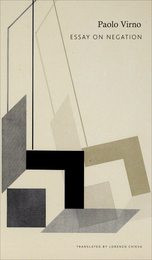 An Essay on Negation: For a Linguistic Anthropology
Paolo Virno
Seagull Books, 2018 A vital addition to Seagull’s growing Italian List that focuses on leftist Italian thought, bringing famous as well as little-known yet crucial voices into the English language.
As speaking animals, we continuously make use of an unassuming grammatical particle, without suspecting that what is at work in its inconspicuousness is a powerful apparatus, which orchestrates language, signification, and the world at large. What particle might this be? The word not.
In Essay on Negation, Paolo Virno argues that the importance of the not is perhaps comparable only to that of money—that is, the universality of exchange. Negation is what separates verbal thought from silent cognitive operations, such as feelings and mental images. Speaking about what is not happening here and now, or about properties that are not referable to a given object, the human animal deactivates its original neuronal empathy, which is prelinguistic; it distances itself from the prescriptions of its own instinctual endowment and accesses a higher sociality, negotiated and unstable, which establishes the public sphere. In fact, the speaking animal soon learns that the negative statement does not amount to the linguistic double of unpleasant realities or destructive emotions: while it rejects them, negation also names them and thus includes them in social life. Virno sees negation as a crucial effect of civilization, one that is, however, also always exposed to further regressions. Taking his cue from a humble word, the author is capable of unfolding the unexpected phenomenology of the negating consciousness.
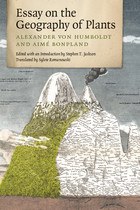 Essay on the Geography of Plants
Alexander von Humboldt and Aimé Bonpland
University of Chicago Press, 2010 The legacy of Alexander von Humboldt (1769–1859) looms large over the natural sciences. His 1799–1804 research expedition to Central and South America with botanist Aimé Bonpland set the course for the great scientific surveys of the nineteenth century, and inspired such essayists and artists as Emerson, Goethe, Thoreau, Poe, and Church.
The chronicles of the expedition were published in Paris after Humboldt’s return, and first among them was the 1807 “Essay on the Geography of Plants.” Among the most cited writings in natural history, after the works of Darwin and Wallace, this work appears here for the first time in a complete English-language translation. Covering far more than its title implies, it represents the first articulation of an integrative “science of the earth, ” encompassing most of today’s environmental sciences. Ecologist Stephen T. Jackson introduces the treatise and explains its enduring significance two centuries after its publication.
 Essay on the Origin of Languages and Writings Related to Music
Jean Jacques Rousseau
Dartmouth College Press, 2009 "J.J. was born for music," Jean-Jacques Rousseau wrote of himself, "not to be consumed in its execution, but to speed its progress and make discoveries about it. His ideas on the art and about the art are fertile, inexhaustible." Rousseau was a practicing musician and theorist for years before publication of his first Discourse, but until now scholars have neglected these ideas. This graceful translation remedies both those failings by bringing together the Essay, which John T. Scott says "most clearly displays the juncture between Rousseau's musical theory and his major philosophical works," with a comprehensive selection of the musical writings. Many of the latter are responses to authors like Rameau, Grimm, and Raynal, and a unique feature of this edition is the inclusion of writings by these authors to help establish the historical and ideological contexts of Rousseau's writings and the intellectual exchanges of which they are a part. With an introduction that provides historical background, traces the development of Rousseau's musical theory, and shows that these writings are not an isolated part of his oeuvre but instead are animated by the same "system," this volume fashions a much-needed portal through which literary scholars, musicologists, historians, and political theorists can enter into an important but hitherto overlooked chamber of Rousseau's vast intellectual palace.
 Essaying Shakespeare
Karen Newman
University of Minnesota Press, 2009 A pioneering scholar of Shakespeare and early modern letters provides an overview of work in the field For more than twenty-five years, Karen Newman has brought her critical acumen to bear on early modern studies. In this collection of her essays on Shakespeare—some acknowledged classics and others never before published—Newman shows how changing theoretical trends have shaped Shakespeare studies, from new historicism and gender studies to critical race studies and globalization. Central to Newman’s work is social exchange, or the circulation of people and objects. At least two of these essays have had a powerful and lasting impact on Shakespeare studies: “Renaissance Family Politics and Shakespeare’s The Taming of the Shrew” and “‘And wash the Ethiop White’: Femininity and the Monstrous in Othello.” Three essays appear in print for the first time: an examination of clothing of the poor and the portrayal of the king as a beggar in Richard II; a stinging review of Harold Bloom’s book Shakespeare: The Invention of the Human; and a rethinking of claims about the globalization of culture and cultural translation. Essaying Shakespeare chronicles Newman’s own critical development to provide a significant map of critical work on Shakespeare.
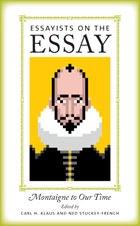 Essayists on the Essay: Montaigne to Our Time
Carl H. Klaus and Ned Stuckey-French
University of Iowa Press, 2012 The first historically and internationally comprehensive collection of its kind, Essayists on the Essay is a path-breaking work that is nothing less than a richly varied sourcebook for anyone interested in the theory, practice, and art of the essay. This unique work includes a selection of fifty distinctive pieces by American, Canadian, English, European, and South American essayists from Montaigne to the present—many of which have not previously been anthologized or translated—as well as a detailed bibliographical and thematic guide to hundreds of additional works about the essay. From a buoyant introduction that provides a sweeping historical and analytic overview of essayists’ thinking about their genre—a collective poetics of the essay—to the detailed headnotes offering pointed information about both the essayists themselves and the anthologized selections, to the richly detailed bibliographic sections, Essayists on the Essay is essential to anyone who cares about the form. This collection provides teachers, scholars, essayists, and readers with the materials they need to take a fresh look at this important but often overlooked form that has for too long been relegated to the role of service genre—used primarily to write about other more “literary” genres or to teach young people how to write. Here, in a single celebratory volume, are four centuries of commentary and theory reminding us of the essay’s storied history, its international appeal, and its relationship not just with poetry and fiction but also with radio, film, video, and new media.
Essayons: Autobiography of John W. Sweetland
John W. Sweetland
Michigan Publishing, 2019 From the humble roots of a small town in Michigan to the building of an entrepreneurial empire, John Sweetland’s life story captures the spirit of the American Dream. This adventurous narrative explores the journey of a young American growing up in the Midwest, his formative years in the military and at university, and his career as a leader of commerce. His background not only laid the foundation for an economist, but also a visionary and philanthropist. Spanning nearly a century, John Sweetland’s autobiography travels broadly with a voice that is reflective and humorous as well as relatable and inspirational.
 Essays and Dialogues
Bartolomeo ScalaTranslated by Renée Neu WatkinsIntroduction by Alison Brown
Harvard University Press, 2008 From humble beginnings, Bartolomeo Scala (1430–1497) trained in the law and rose to prominence as a leading citizen of Florence, serving as secretary and treasurer to the Medicis and chancellor of the Guelf party before becoming first chancellor of Florence, a post he held for fifteen years. His palace in Borgo Pinti, modeled on classical designs, was emblematic of his achievements as a humanist as well as a public official. Along with his professional writings as chancellor, Scala’s personal treatises, fables, and dialogues—widely read and admired by his contemporaries—were deeply indebted to classical sources. This volume collects works from throughout his career that show his acquaintance with recently rediscovered ancient writers, whose works he had access to through the Medici libraries, and the influence of fellow humanists such as Marsilio Ficino, Aeneas Silvius Piccolomini (Pope Pius II), and Giovanni Pico della Mirandola. Perhaps the most significant is the Defense against the Detractors of Florence, a key document in the development of modern republicanism.
This volume presents fresh translations by Renée Neu Watkins of five of the texts based on Latin editions by Alison Brown, who also contributes an introduction to Scala’s life and works.
Essays and Studies in English and Comparative Literature
Members of the English Department of the University of Michigan
University of Michigan Press, 1935 Essays and Studies in English and Comparative Literature is a collection of scholarly works authored by members of the University of Michigan's English Department. It investigates various aspects of English and comparative literature, including studies on Middle English dialect characteristics, fifteenth-century spellings, place-name derivations, and early treatises on Latin grammar. In addition, it explores the origins and developments of specific linguistic features such as the voiceless preterit and past participle inflections of English irregular weak verbs. This comprehensive examination of historical and linguistic topics contributes significant insights to the field of literary studies.
Essays and Studies in English and Comparative Literature
Members of the English Department of the University of Michigan
University of Michigan Press, 1932 Essays and Studies in English and Comparative Literature is a collection of scholarly essays written by members of the English Department of the University of Michigan. The book features in-depth studies on diverse topics such as the traditional development of the character Diomede, peculiarities in Shakespearean texts, the Italianate background of The Merry Wives of Windsor, and political aspects in Dryden's works. Contributors explore the aesthetic theories of Shelley, Keats, and Poe, and offer a bibliographical essay on Chrétien de Troyes, among other significant literary examinations. This compilation reflects the academic rigor and critical insights of its esteemed authors, providing valuable contributions to English and Comparative Literature studies.
 Essays, Comments, and Reviews
William James
Harvard University Press, 1987 This generous omnium-gatherum brings together all the writings William James published that have not appeared in previous volumes of this definitive edition of his works. Miscellaneous and diverse though the pieces are, they are unified by James's style and personality, which shine through even the slightest of them.
The volume includes 25 essays, 44 letters to the editor commenting on sundry topics, and 113 reviews of a wide range of works in English, French, German, and Italian. Twenty-three of the items are not recorded in any bibliography of James's writings. Two of the new discoveries are of particular interest: dating from 1865, when he was still a medical student, they are James's earliest known publications and give his first published views on Darwinian biology, which was to affect profoundly his own work in philosophy and psychology. Among his reviews are one of "Ueber den psychischen Mechanismus hysterischer Phäomene," by Josef Breuer and Sigmund Freud, published a year after the first appearance of that historically famous essay, and showing the breadth of James's interests, reviews of George Santayana's Sense of Beauty (1897) and Bernard Berenson's Florentine Painters of the Renaissance (1896).
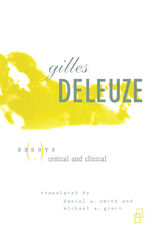 Essays Critical And Clinical
Gilles Deleuze
University of Minnesota Press, 1997 The final work of this essential thinker. Essays Critical and Clinical is the final work of the late Gilles Deleuze, one of the most important and vital figures in contemporary philosophy. It includes essays, all newly revised or published here for the first time, on such diverse literary figures as Herman Melville, Walt Whitman, D. H. Lawrence, T. E. Lawrence, Samuel Beckett, Leopold von Sacher-Masoch, Alfred Jarry, and Lewis Carroll, as well as philosophers such as Plato, Spinoza, Kant, Nietzsche, and Heidegger. For Deleuze, every literary work implies a way of living, a form of life, and must be evaluated not only critically but also clinically. As Proust said, great writers invent a new language within language, but in such a way that language in its entirety is pushed to its limit or its own “outside.” This outside of language is made up of affects and precepts that are not linguistic, but which language alone nonetheless makes possible. In Essays Critical and Clinical, Deleuze is concerned with the delirium-the process of Life-that lies behind this invention, as well as the loss that occurs, the silence that follows, when this delirium becomes a clinical state. Taken together, these eighteen essays present a profoundly new approach to literature by one of the greatest twentieth-century philosophers.
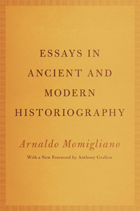 Essays in Ancient and Modern Historiography
Arnaldo Momigliano
University of Chicago Press, 2012 Arnaldo Momigliano was one of the foremost classical historiographers of the twentieth century. This collection of twenty-one carefully selected essays is remarkable both in the depth of its scholarship and the breadth of its subjects. Moving with ease across the centuries, Momigliano supplements powerful readings of writers in the Greek, Jewish, and Roman traditions, such as Tacitus and Polybius, with writings that focus on later historians, such as Vico and Croce. Charmingly written and concise, these pieces range from review essays reprinted from the New York Review of Books to treatises on the nature of historical scholarship. Essays in Ancient and Modern Historiography is a brilliant reminder of Momigliano’s profound knowledge of classical civilization and his gift for deftly handling prose. With a new Foreword by Anthony Grafton, this volume is essential reading for any student of classics or historiography.
 Essays in Ancient Philosophy
Michael Frede
University of Minnesota Press, 1987 Essays in Ancient Philosophy was first published in 1987. Minnesota Archive Editions uses digital technology to make long-unavailable books once again accessible, and are published unaltered from the original University of Minnesota Press editions. To understand ancient philosophy "in its concrete, complex detail," Michael Frede says, "one has also to look at all the other histories to which it is tied by an intricate web of casual connections which run both ways." Frede's distinctive approach to the history of ancient philosophy is closely tied to his specific interests within the field - the Hellenistic philosophers and those of late antiquity, who are the primary subjects of this book. Long ignored or even maligned, the Stoics and Skeptics, medical philosophers, and grammarians are extremely interesting once their actual views are reconstructed and it is possible to recognize their ties to earlier and later philosophical thought. Refusing to study them as paradigms of achievement, or to seek purely philosophical explanations for their views, Frede draws instead upon those "other histories"—of religion, social structure, law and politics—to illuminate their work and to show how it was interpreted and transformed by succeeding generations.
Essays in Comparative Social Stratification
Leonard Plotnicov
University of Pittsburgh Press, 1970
The essays in this volume represent trends in social stratification studies undertaken in major culture areas of the world. The empirical data of the chapters are set with special reference to the dynamics of processes within these diverse traditions and heritages as sources of comparison with one another and with the experiences of western societies.
Essays in International Economics
J. Marcus Fleming
Harvard University Press, 1971 J. Marcus Fleming, who applies economic theory to problems of international economic policy, has long advised policy makers national and international. The three pieces in Part I of his book apply the theory of the "second best"—a branch of welfare economics in which the author was a pioneer—to problems of trade discrimination and restriction. Part II consists of four essays on international liquidity and reflects the author's role in the inauguration of a new type of fiduciary international reserve asset—the Special Drawing Right of the International Monetary Fund. The seven essays of Part III, two of which are published for the first time, deal with various aspects of the process of removing disequilibria in international payments with the least possible sacrifice of domestic economic objectives.
Essays in Jewish Thought
Nahum Glatzer
University of Alabama Press, 2009 Examines and explores divers topics of Jewish thought and history
A fascinating and eclectic collection of twenty-two essays, Essays in Jewish Thought examines and explores diverse topics of Jewish thought and history. From Judaism’s view of ancient Rome at its imperial apogee and the Dead Sea Scrolls to Jewish thought in Europe’s revolutions of 1848 and Franz Kafka, the collection offers a rich compendium of essays of interest to scholars, historians, philosophers, and students.
Essays in Linguistics: Dialectology, Grammar, and Lexicography in Honor of James B. Mcmillan
James C. Raymond
University of Alabama Press, 2004 "Raymond and Russell have fashioned a lively, useful volume. . . . The ability and integrity of the contributors make much of the difference, but the editors have given the book direction by soliciting state of the art essays in three fields . . . dialectology (the articles represent area linguistics at its best), grammar and usage (Algeo on usage shibboleths is particularly fine), and lexicography (a delight)."
—Choice
"These essays are quietly unassuming in tone but highly useful."
—Language in Society
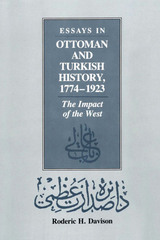 Essays in Ottoman and Turkish History, 1774-1923: The Impact of the West
By Roderic H. Davison
University of Texas Press, 1990 The effect of Western influence on the later Ottoman Empire and on the development of the modern Turkish nation-state links these twelve essays by a prominent American scholar. Roderic Davison draws from his extensive knowledge of Western diplomatic history and Turkish history to describe a period in which the actions of the Great Powers, incipient and rising nationalisms, and Westernizing reforms shaped the destiny of the Ottoman Empire and the creation of the new Turkish Republic. Eleven of the essays were previously published in widely scattered journals and multi-authored volumes. The first of these provides a general survey of Turkish and Ottoman history, from early Turkish times to the end of the Empire. The following essays continue chronologically from 1774, detailing some of the changes in the nineteenth-century Empire. Several themes recur. One is the impact of Western ideas and institutions and the resistance to that influence by some elements in the Empire. Another concerns the diplomatic pressure exerted by the Great Powers of Europe on the Empire, which amounted at times to direct intervention in Ottoman domestic affairs. Taken together, the essays portray a confluence of civilizations as well as a clash of cultures. Professor Davison has written an interpretive introduction that sets out the historical trends running throughout the book. In addition, he includes a previously unpublished article on the advent of the electric telegraph in the Ottoman Empire to show how the adoption of a Western technological advance could affect many areas of life. Of particular interest to students of Ottoman and Middle East history, these essays will also be valuable for everyone concerned with modernization in developing nations. Davison's interpretations and keen methodological sense also shed new light on several aspects of European diplomatic history.
Essays in Philosophical Analysis
Nicholas Rescher
University of Pittsburgh Press, 1969 This book presents twenty essays by Nicholas Rescher, representing more than a decade of his work. The first part of the collection offers thoughts on the history of philosophy from the Presocratics to the twentieth century; the second part features essays on epistemology, the philosophy of science, metaphysics, the theory of historiography, and the logic of temporal concepts. Despite the range of topics, all essays are closely integrated at the methodological level.
Essays in Philosophy
William James
Harvard University Press, 1978 Essays in Philosophy brings together twenty-one essays, reviews, and occasional pieces published by James between 1876 and 1910. They range in subject from a concern with the teaching of philosophy and appraisals of philosophers to analyses of important problems.
Several of the essays, like "The Sentiment of Rationality" and "The Knowing of Things Together," are of particular significance in the development of the views of James's later works. All of them, as John McDermott says in his Introduction, are in a style that is "engaging and personal...witty, acerbic, compassionate, and polemical." Whether he is writing an article for the Nation of a definition of "Experience" for Baldwin's Dictionary or "The Mad Absolute" for the Journal of Philosophy, James is always unmistakably himself, and always readable.
Essays in Positive Economics
Milton Friedman
University of Chicago Press, 1966 "Stimulating, provocative, often infuriating, but well worth reading."—Peter Newman, Economica
"His critical blast blows like a north wind against the more pretentious erections of modern economics. It is however a healthy and invigorating blast, without malice and with a sincere regard for scientific objectivity."—K.E. Boulding, Political Science Quarterly
"Certainly one of the most engrossing volumes that has appeared recently in economic theory."—William J. Baumol, Review of Economics and Statistics
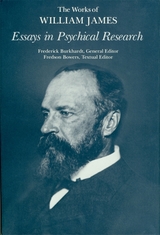 Essays in Psychical Research
William James
Harvard University Press, 1986 The more than fifty articles, essays, and reviews in this volume, collected here for the first time, were published by William James over a span of some twenty-five years. The record of a sustained interest in phenomena of a highly controversial nature, they make it amply clear that James's work in psychical research was not an eccentric hobby but a serious and sympathetic concern. James was broad-minded in his approach but tough-minded in his demand that investigations be conducted in rigorous scientific terms. He hoped his study of psychic phenomena would strengthen the philosophy of an open-ended, pluralistic universe that he was formulating during the same period, and he looked forward to the new horizons for human experience that a successful outcome of his research would create.
Robert A. McDermott, in his Introduction, discusses the relation of these essays to James's other work in philosophy, psychology, and religion.
Essays in Psychology
Frederick Burkhardt, General EditorFredson Bowers, Textual EditorIgnas K. Skrupskelis, Associate EditorIntroduction by William R. Woodward
Harvard University Press, 1983 The twenty-nine articles, essays, and reviews in this volume, collected here for the first time, were published by William James over a long span of years, from 1878 (twelve years prior to The Principles of Psychology) to 1906. Some are theoretical; others examine specific psychological phenomena or report the results of experiments James had conducted.
Written for the most part for a scholarly rather than a popular audience, they exhibit James's characteristic lucidity and persuasiveness, and they reveal the roots and development of his view on a wide range of psychological issues. As William R. Woodward notes in his Introduction, these essays "bring the reader closer to James's sources, thereby illuminating his indebtedness to tradition as well as his creative departure from it."
 Essays in Radical Empiricism
William James
Harvard University Press, 1976 A pioneer in early studies of the human mind and founder of that peculiarly American philosophy called Pragmatism, William James remains America's most widely read philosopher. Generations of students have been drawn to his lucid presentations of philosophical problems. His works, now being made available for the first time in a definitive edition, have a permanent place in American letters and a continuing influence in philosophy and psychology.The essays gathered in the posthumously published Essays in Radical Empiricism formulate ideas that had brewed in James's mind for thirty years as he sought a way out of the philosophical dilemmas generated by the new psychology of the late nineteenth century. They constitute the explanatory core of his doctrine of radical empiricism, a doctrine that charts his course between the absolute idealism he could not accept and, at the other extreme, the law of associationism, which reduces knowledge to sheer contiguity of ideas. In his introduction John J. McDermott describes the historical background and the genesis of James's theory and considers the objections raised by its opponents.
 Essays in Religion and Morality
William James
Harvard University Press, 1982 Essays in Religion and Morality brings together a dozen papers of varying length to these two themes so crucial to the life and thought of William James. Reflections on the two subjects permeate, first, James's presentation of his father's Literary Remains; second, his writings on human immortality and the relation between reason and faith; third, his two memorial pieces, one on Robert Gould Shaw and the other on Emerson; fourth, his consideration of the energies and powers of human life; and last, his writings on the possibilities of peace, especially as found in his famous essay "The Moral Equivalent of War."
These speeches and essays were written over a period of twenty-four years. The fact that James did not collect and publish them himself in a single volume does not reflect on their intrinsic worth or on their importance in James's philosophical work, since they include some of the best known and most influential of his writings. All the essays, throughout their varied subject matter, are consistently and characteristically Jamesian in the freshness of their attack on the problems and failings of humankind and in their steady faith in human powers.
 Essays in the Economics of Uncertainty
Jean-Jacques Laffont
Harvard University Press, 1980 These three elegant essays develop principles central to the understanding of the diverse ways in which imperfect information affects the distribution of resources, incentives, and the evaluation of economic policy. The first concerns the special role that information plays in the allocation process when it is possible to improve accuracy through private investment. The common practice of hiring “experts” whose information is presumably much better than their clients' is analyzed. Issues of cooperative behavior when potential group members possess diverse pieces of information are addressed. Emphasis is placed on the adaptation of the “core” concept from game theory to the resource allocation model with differential information.
The second essay deals with the extent to which agents can influence the random events they face. This is known as moral hazard, and in its presence there is a potential inefficiency in the economic system. Two special models are studied: the role of moral hazard in a monetary economy, and the role of an outside adjudicatory agency that has the power to enforce fines and compensation.
The final essay discusses the problem of certainty equivalence in economic policy. Conditions under which a full stochastic optimization can be calculated by solving a related, much simpler “certainty equivalence” problem are developed. The reduction in the complexity of calculation involved is very great compared with the potential loss of efficiency.
|
|
